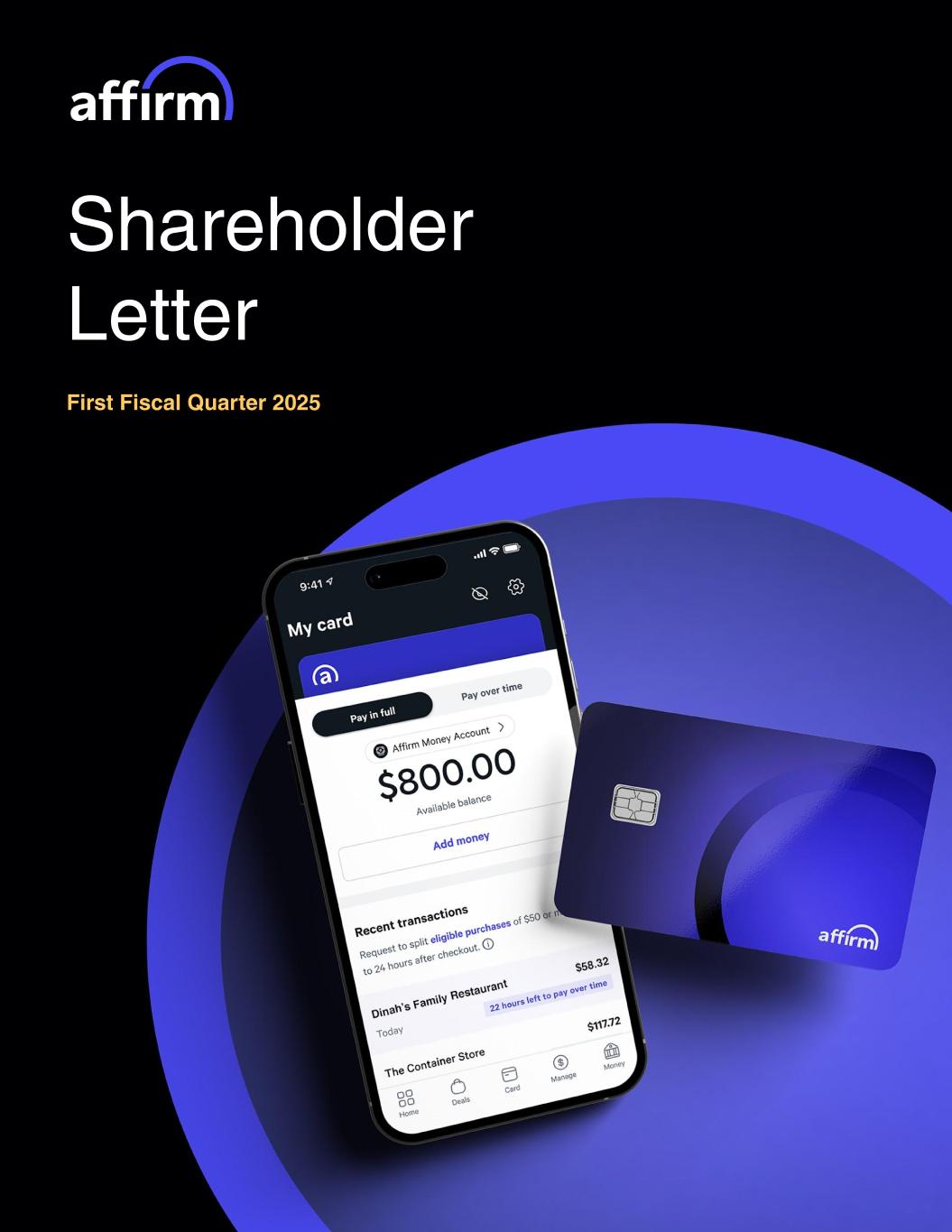
Shareholder Letter First Fiscal Quarter 2025
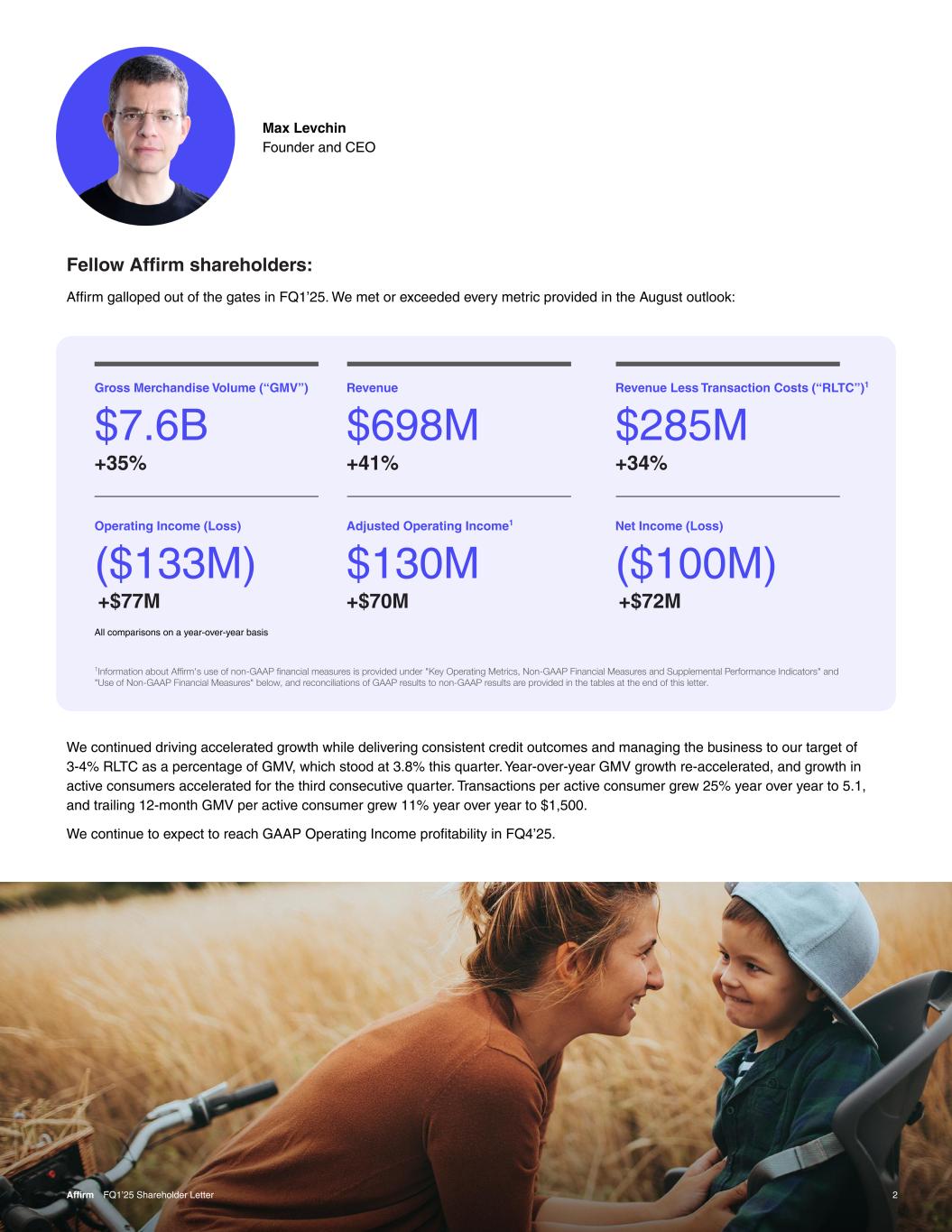
2Affirm FQ1’25 Shareholder Letter Fellow Affirm shareholders: Affirm galloped out of the gates in FQ1’25. We met or exceeded every metric provided in the August outlook: Max Levchin Founder and CEO We continued driving accelerated growth while delivering consistent credit outcomes and managing the business to our target of 3-4% RLTC as a percentage of GMV, which stood at 3.8% this quarter. Year-over-year GMV growth re-accelerated, and growth in active consumers accelerated for the third consecutive quarter. Transactions per active consumer grew 25% year over year to 5.1, and trailing 12-month GMV per active consumer grew 11% year over year to $1,500. We continue to expect to reach GAAP Operating Income profitability in FQ4’25. Gross Merchandise Volume (“GMV”) $7.6B +35% Operating Income (Loss) ($133M) +$77M Revenue $698M +41% Adjusted Operating Income1 $130M +$70M Revenue Less Transaction Costs (“RLTC”)1 $285M +34% Net Income (Loss) ($100M) +$72M All comparisons on a year-over-year basis 1Information about Affirm's use of non-GAAP financial measures is provided under "Key Operating Metrics, Non-GAAP Financial Measures and Supplemental Performance Indicators" and "Use of Non-GAAP Financial Measures" below, and reconciliations of GAAP results to non-GAAP results are provided in the tables at the end of this letter.
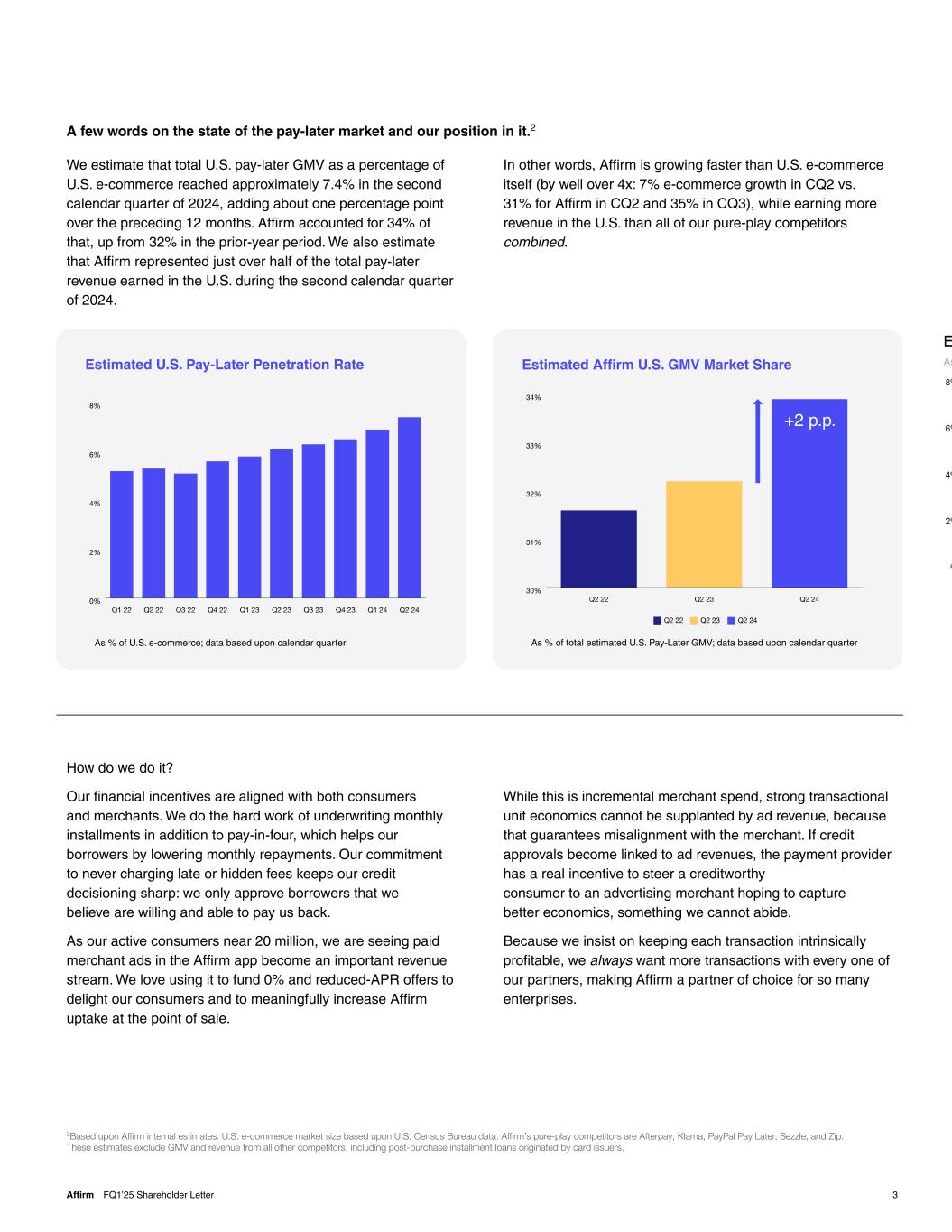
3Affirm FQ1’25 Shareholder Letter 2Based upon Affirm internal estimates. U.S. e-commerce market size based upon U.S. Census Bureau data. Affirm’s pure-play competitors are Afterpay, Klarna, PayPal Pay Later, Sezzle, and Zip. These estimates exclude GMV and revenue from all other competitors, including post-purchase installment loans originated by card issuers. A few words on the state of the pay-later market and our position in it.2 While this is incremental merchant spend, strong transactional unit economics cannot be supplanted by ad revenue, because that guarantees misalignment with the merchant. If credit approvals become linked to ad revenues, the payment provider has a real incentive to steer a creditworthy consumer to an advertising merchant hoping to capture better economics, something we cannot abide. Because we insist on keeping each transaction intrinsically profitable, we always want more transactions with every one of our partners, making Affirm a partner of choice for so many enterprises. Estimated U.S. Pay-Later Penetration Rate As % of U.S. e-commerce; data based upon calendar quarter Estimated Affirm U.S. GMV Market Share As % of total estimated U.S. Pay-Later GMV; data based upon calendar quarter +2 p.p. How do we do it? Our financial incentives are aligned with both consumers and merchants. We do the hard work of underwriting monthly installments in addition to pay-in-four, which helps our borrowers by lowering monthly repayments. Our commitment to never charging late or hidden fees keeps our credit decisioning sharp: we only approve borrowers that we believe are willing and able to pay us back. As our active consumers near 20 million, we are seeing paid merchant ads in the Affirm app become an important revenue stream. We love using it to fund 0% and reduced-APR offers to delight our consumers and to meaningfully increase Affirm uptake at the point of sale. In other words, Affirm is growing faster than U.S. e-commerce itself (by well over 4x: 7% e-commerce growth in CQ2 vs. 31% for Affirm in CQ2 and 35% in CQ3), while earning more revenue in the U.S. than all of our pure-play competitors combined. We estimate that total U.S. pay-later GMV as a percentage of U.S. e-commerce reached approximately 7.4% in the second calendar quarter of 2024, adding about one percentage point over the preceding 12 months. Affirm accounted for 34% of that, up from 32% in the prior-year period. We also estimate that Affirm represented just over half of the total pay-later revenue earned in the U.S. during the second calendar quarter of 2024.
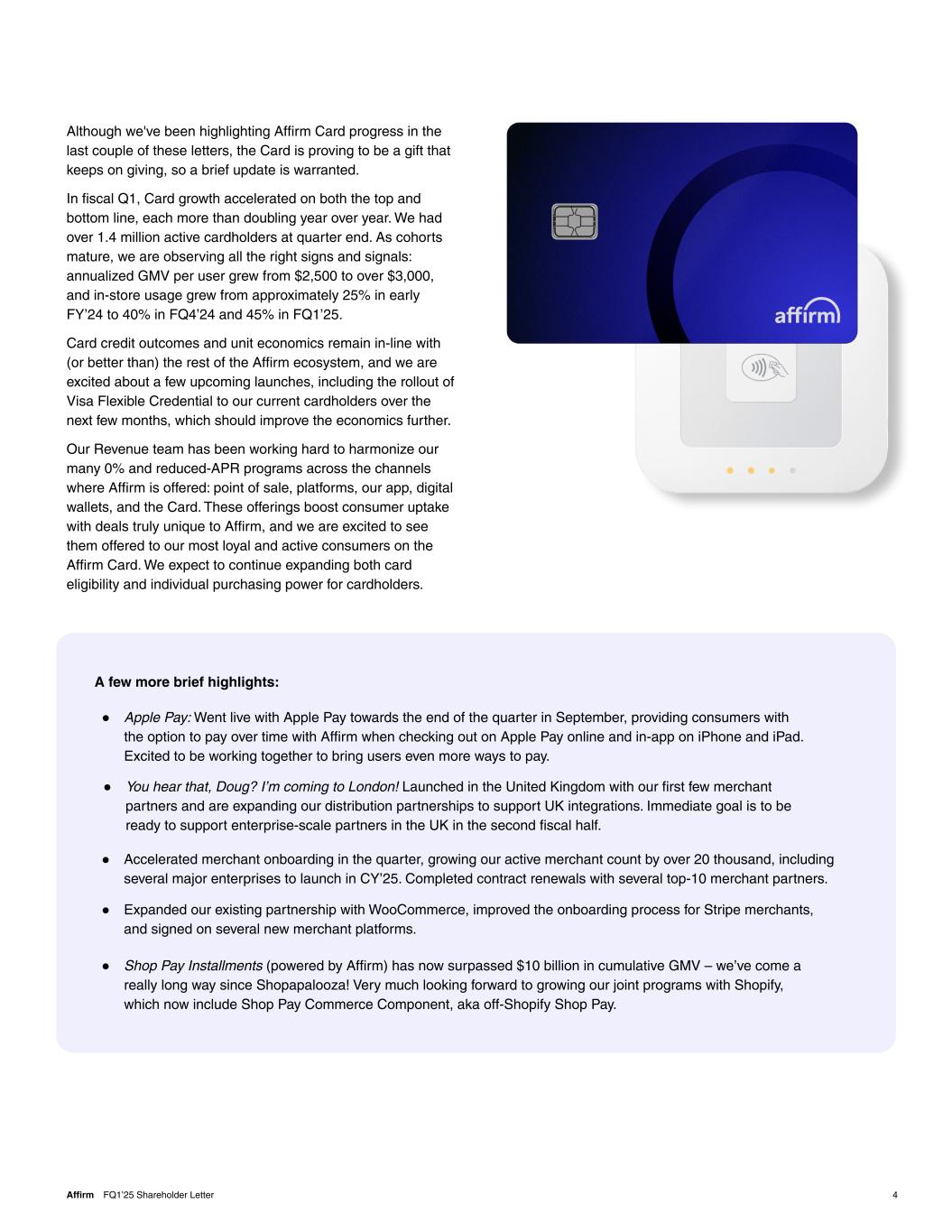
4Affirm FQ1’25 Shareholder Letter Although we've been highlighting Affirm Card progress in the last couple of these letters, the Card is proving to be a gift that keeps on giving, so a brief update is warranted. In fiscal Q1, Card growth accelerated on both the top and bottom line, each more than doubling year over year. We had over 1.4 million active cardholders at quarter end. As cohorts mature, we are observing all the right signs and signals: annualized GMV per user grew from $2,500 to over $3,000, and in-store usage grew from approximately 25% in early FY’24 to 40% in FQ4’24 and 45% in FQ1’25. Card credit outcomes and unit economics remain in-line with (or better than) the rest of the Affirm ecosystem, and we are excited about a few upcoming launches, including the rollout of Visa Flexible Credential to our current cardholders over the next few months, which should improve the economics further. Our Revenue team has been working hard to harmonize our many 0% and reduced-APR programs across the channels where Affirm is offered: point of sale, platforms, our app, digital wallets, and the Card. These offerings boost consumer uptake with deals truly unique to Affirm, and we are excited to see them offered to our most loyal and active consumers on the Affirm Card. We expect to continue expanding both card eligibility and individual purchasing power for cardholders. A few more brief highlights: ● Apple Pay: Went live with Apple Pay towards the end of the quarter in September, providing consumers with the option to pay over time with Affirm when checking out on Apple Pay online and in-app on iPhone and iPad. Excited to be working together to bring users even more ways to pay. ● You hear that, Doug? I’m coming to London! Launched in the United Kingdom with our first few merchant partners and are expanding our distribution partnerships to support UK integrations. Immediate goal is to be ready to support enterprise-scale partners in the UK in the second fiscal half. ● Shop Pay Installments (powered by Affirm) has now surpassed $10 billion in cumulative GMV – we’ve come a really long way since Shopapalooza! Very much looking forward to growing our joint programs with Shopify, which now include Shop Pay Commerce Component, aka off-Shopify Shop Pay. ● Expanded our existing partnership with WooCommerce, improved the onboarding process for Stripe merchants, and signed on several new merchant platforms. ● Accelerated merchant onboarding in the quarter, growing our active merchant count by over 20 thousand, including several major enterprises to launch in CY’25. Completed contract renewals with several top-10 merchant partners.
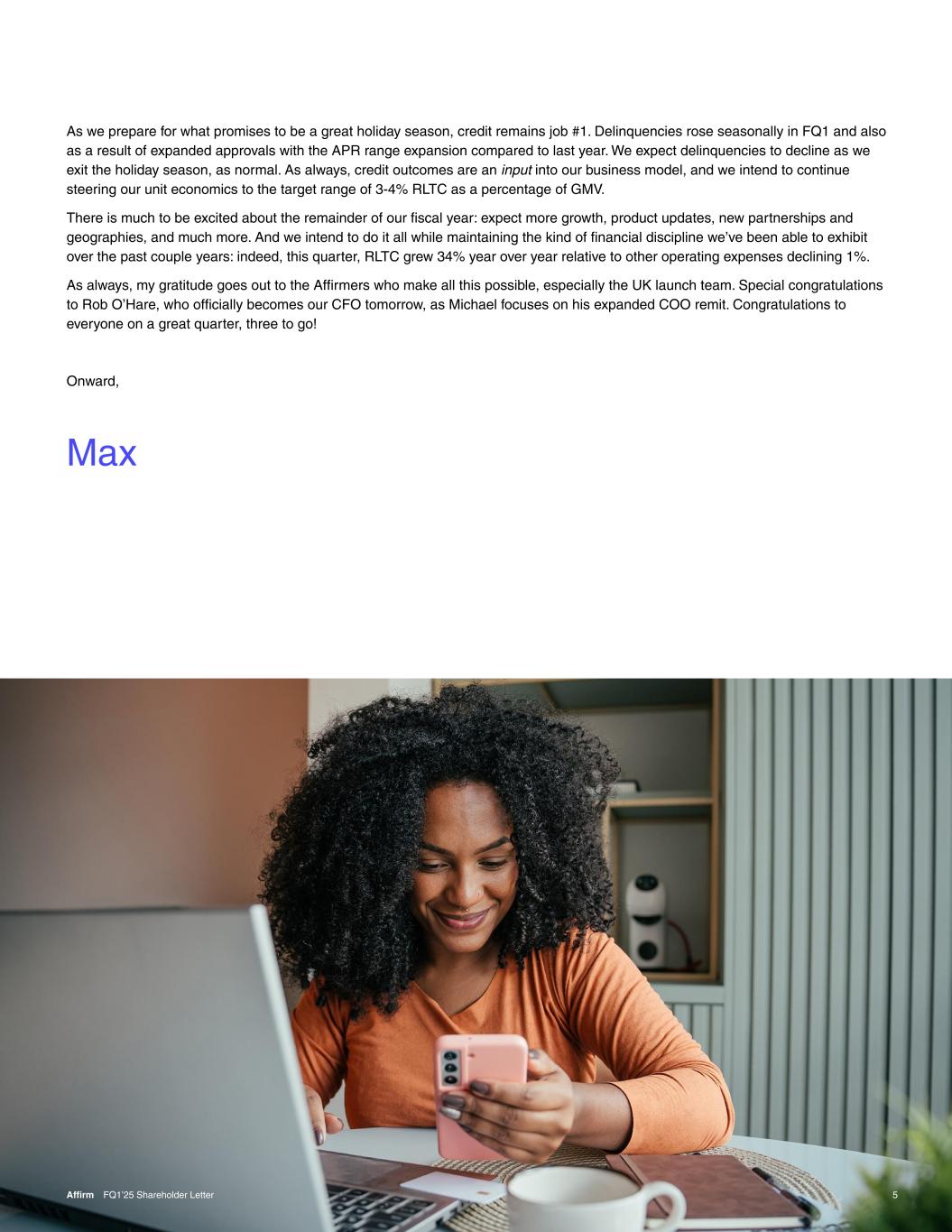
5Affirm FQ1’25 Shareholder Letter As we prepare for what promises to be a great holiday season, credit remains job #1. Delinquencies rose seasonally in FQ1 and also as a result of expanded approvals with the APR range expansion compared to last year. We expect delinquencies to decline as we exit the holiday season, as normal. As always, credit outcomes are an input into our business model, and we intend to continue steering our unit economics to the target range of 3-4% RLTC as a percentage of GMV. There is much to be excited about the remainder of our fiscal year: expect more growth, product updates, new partnerships and geographies, and much more. And we intend to do it all while maintaining the kind of financial discipline we’ve been able to exhibit over the past couple years: indeed, this quarter, RLTC grew 34% year over year relative to other operating expenses declining 1%. As always, my gratitude goes out to the Affirmers who make all this possible, especially the UK launch team. Special congratulations to Rob O’Hare, who officially becomes our CFO tomorrow, as Michael focuses on his expanded COO remit. Congratulations to everyone on a great quarter, three to go! Onward, Max First Payment 30+ Day Delinquency Rate First Payment 30 Day Delinquency Rate measures the rate of monthly installment loans 30+ days delinquent on first payment from the time of loan capture.
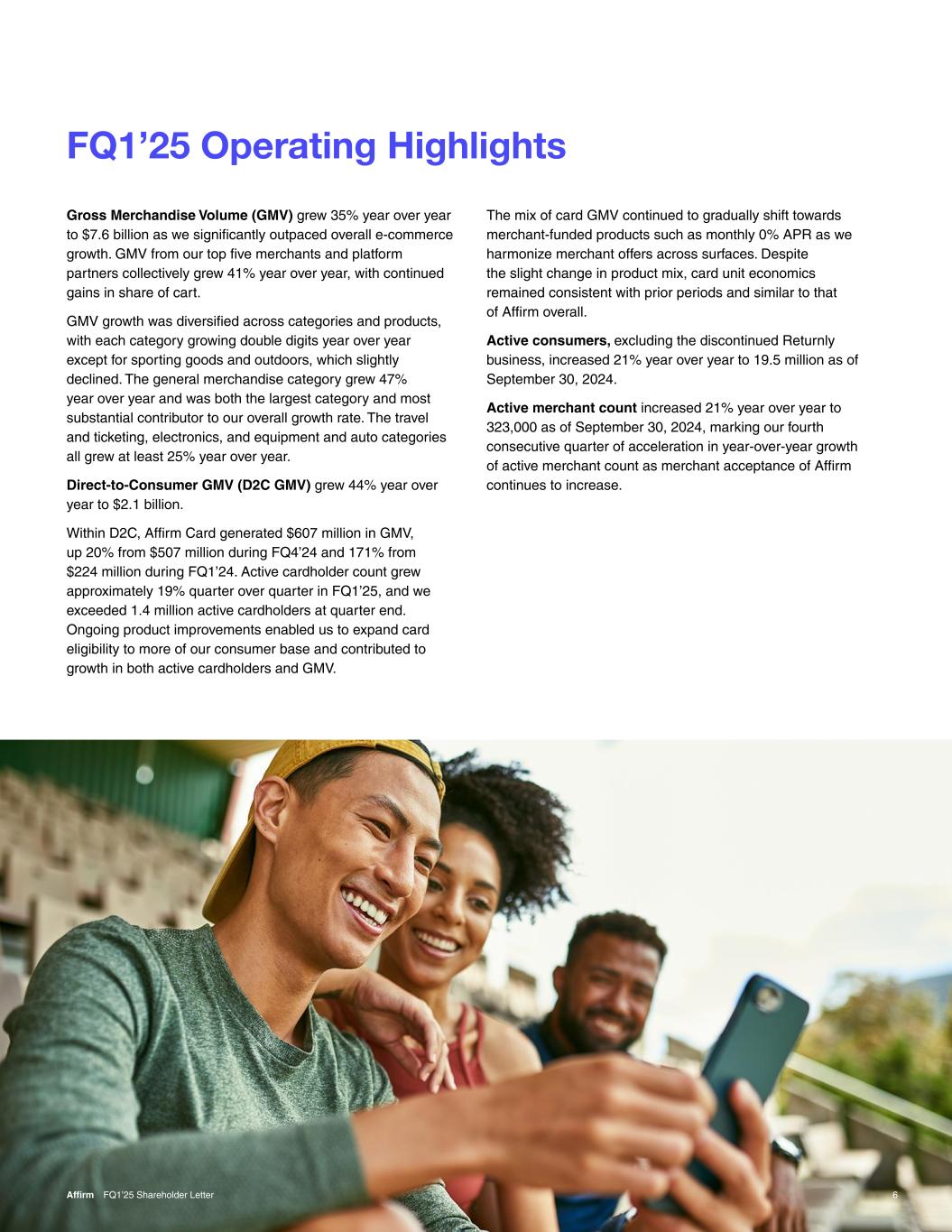
FQ1’25 Operating Highlights 6 Gross Merchandise Volume (GMV) grew 35% year over year to $7.6 billion as we significantly outpaced overall e-commerce growth. GMV from our top five merchants and platform partners collectively grew 41% year over year, with continued gains in share of cart. GMV growth was diversified across categories and products, with each category growing double digits year over year except for sporting goods and outdoors, which slightly declined. The general merchandise category grew 47% year over year and was both the largest category and most substantial contributor to our overall growth rate. The travel and ticketing, electronics, and equipment and auto categories all grew at least 25% year over year. Direct-to-Consumer GMV (D2C GMV) grew 44% year over year to $2.1 billion. Within D2C, Affirm Card generated $607 million in GMV, up 20% from $507 million during FQ4’24 and 171% from $224 million during FQ1’24. Active cardholder count grew approximately 19% quarter over quarter in FQ1’25, and we exceeded 1.4 million active cardholders at quarter end. Ongoing product improvements enabled us to expand card eligibility to more of our consumer base and contributed to growth in both active cardholders and GMV. The mix of card GMV continued to gradually shift towards merchant-funded products such as monthly 0% APR as we harmonize merchant offers across surfaces. Despite the slight change in product mix, card unit economics remained consistent with prior periods and similar to that of Affirm overall. Active consumers, excluding the discontinued Returnly business, increased 21% year over year to 19.5 million as of September 30, 2024. Active merchant count increased 21% year over year to 323,000 as of September 30, 2024, marking our fourth consecutive quarter of acceleration in year-over-year growth of active merchant count as merchant acceptance of Affirm continues to increase. Affirm FQ1’25 Shareholder Letter
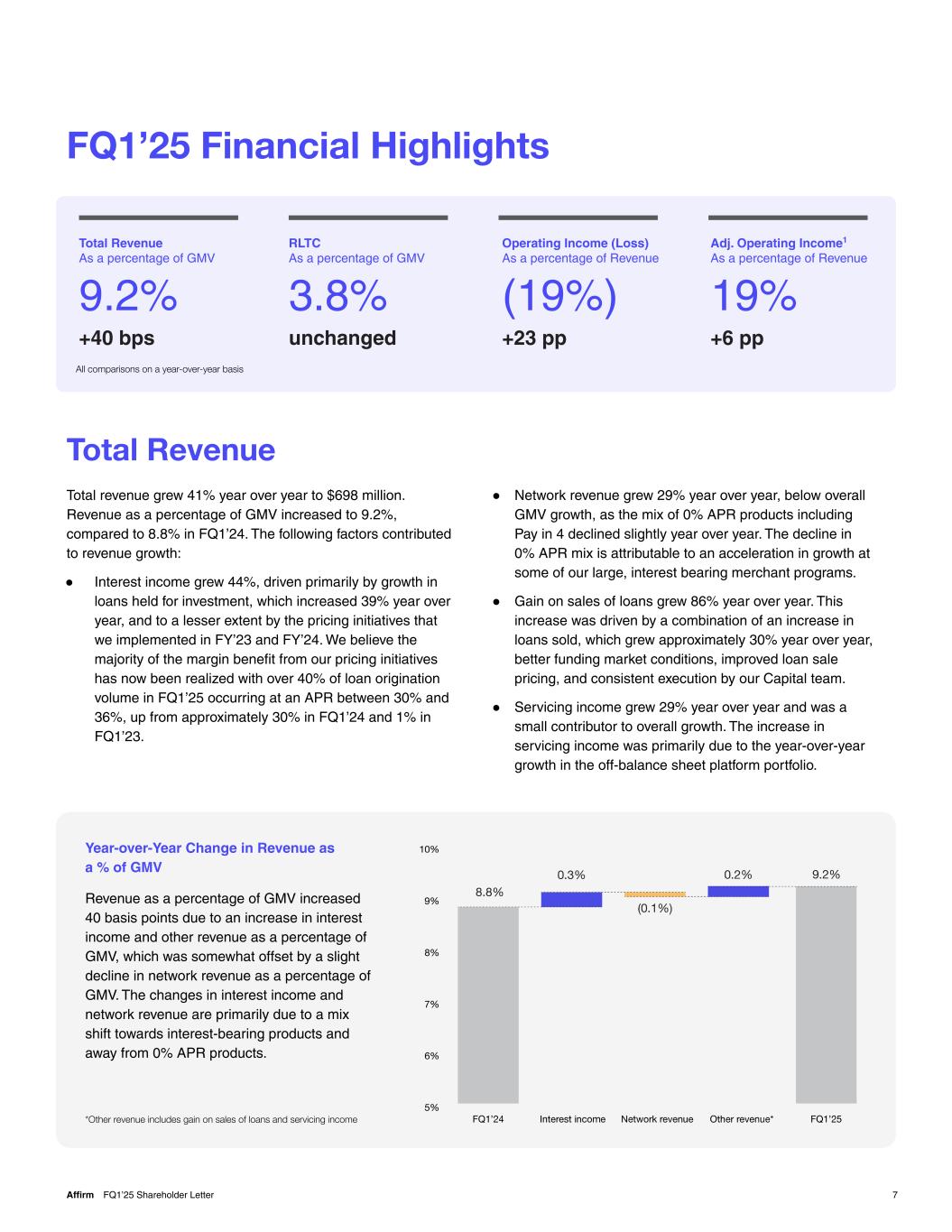
FQ1’25 Financial Highlights Total Revenue Total revenue grew 41% year over year to $698 million. Revenue as a percentage of GMV increased to 9.2%, compared to 8.8% in FQ1’24. The following factors contributed to revenue growth: ● Interest income grew 44%, driven primarily by growth in loans held for investment, which increased 39% year over year, and to a lesser extent by the pricing initiatives that we implemented in FY’23 and FY’24. We believe the majority of the margin benefit from our pricing initiatives has now been realized with over 40% of loan origination volume in FQ1’25 occurring at an APR between 30% and 36%, up from approximately 30% in FQ1’24 and 1% in FQ1’23. ● Network revenue grew 29% year over year, below overall GMV growth, as the mix of 0% APR products including Pay in 4 declined slightly year over year. The decline in 0% APR mix is attributable to an acceleration in growth at some of our large, interest bearing merchant programs. ● Gain on sales of loans grew 86% year over year. This increase was driven by a combination of an increase in loans sold, which grew approximately 30% year over year, better funding market conditions, improved loan sale pricing, and consistent execution by our Capital team. ● Servicing income grew 29% year over year and was a small contributor to overall growth. The increase in servicing income was primarily due to the year-over-year growth in the off-balance sheet platform portfolio. Total Revenue As a percentage of GMV 9.2% +40 bps RLTC As a percentage of GMV 3.8% unchanged Adj. Operating Income1 As a percentage of Revenue 19% +6 pp All comparisons on a year-over-year basis Operating Income (Loss) As a percentage of Revenue (19%) +23 pp Affirm FQ1’25 Shareholder Letter 7 Year-over-Year Change in Revenue as a % of GMV *Other revenue includes gain on sales of loans and servicing income Revenue as a percentage of GMV increased 40 basis points due to an increase in interest income and other revenue as a percentage of GMV, which was somewhat offset by a slight decline in network revenue as a percentage of GMV. The changes in interest income and network revenue are primarily due to a mix shift towards interest-bearing products and away from 0% APR products.
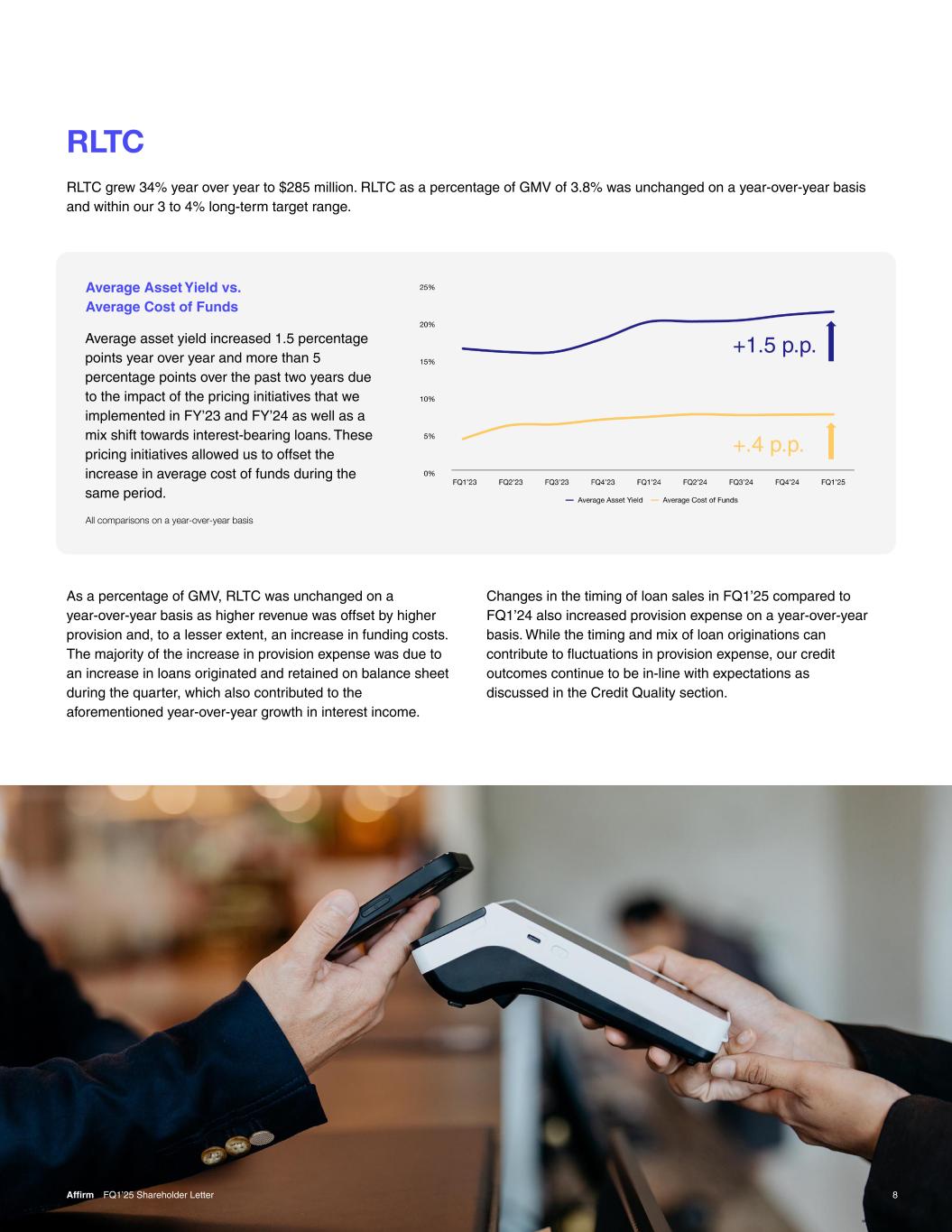
8Affirm FQ1’25 Shareholder Letter RLTC As a percentage of GMV, RLTC was unchanged on a year-over-year basis as higher revenue was offset by higher provision and, to a lesser extent, an increase in funding costs. The majority of the increase in provision expense was due to an increase in loans originated and retained on balance sheet during the quarter, which also contributed to the aforementioned year-over-year growth in interest income. Changes in the timing of loan sales in FQ1’25 compared to FQ1’24 also increased provision expense on a year-over-year basis. While the timing and mix of loan originations can contribute to fluctuations in provision expense, our credit outcomes continue to be in-line with expectations as discussed in the Credit Quality section. RLTC grew 34% year over year to $285 million. RLTC as a percentage of GMV of 3.8% was unchanged on a year-over-year basis and within our 3 to 4% long-term target range. Average Asset Yield vs. Average Cost of Funds +1.5 p.p. +.4 p.p. Average asset yield increased 1.5 percentage points year over year and more than 5 percentage points over the past two years due to the impact of the pricing initiatives that we implemented in FY’23 and FY’24 as well as a mix shift towards interest-bearing loans. These pricing initiatives allowed us to offset the increase in average cost of funds during the same period. All comparisons on a year-over-year basis
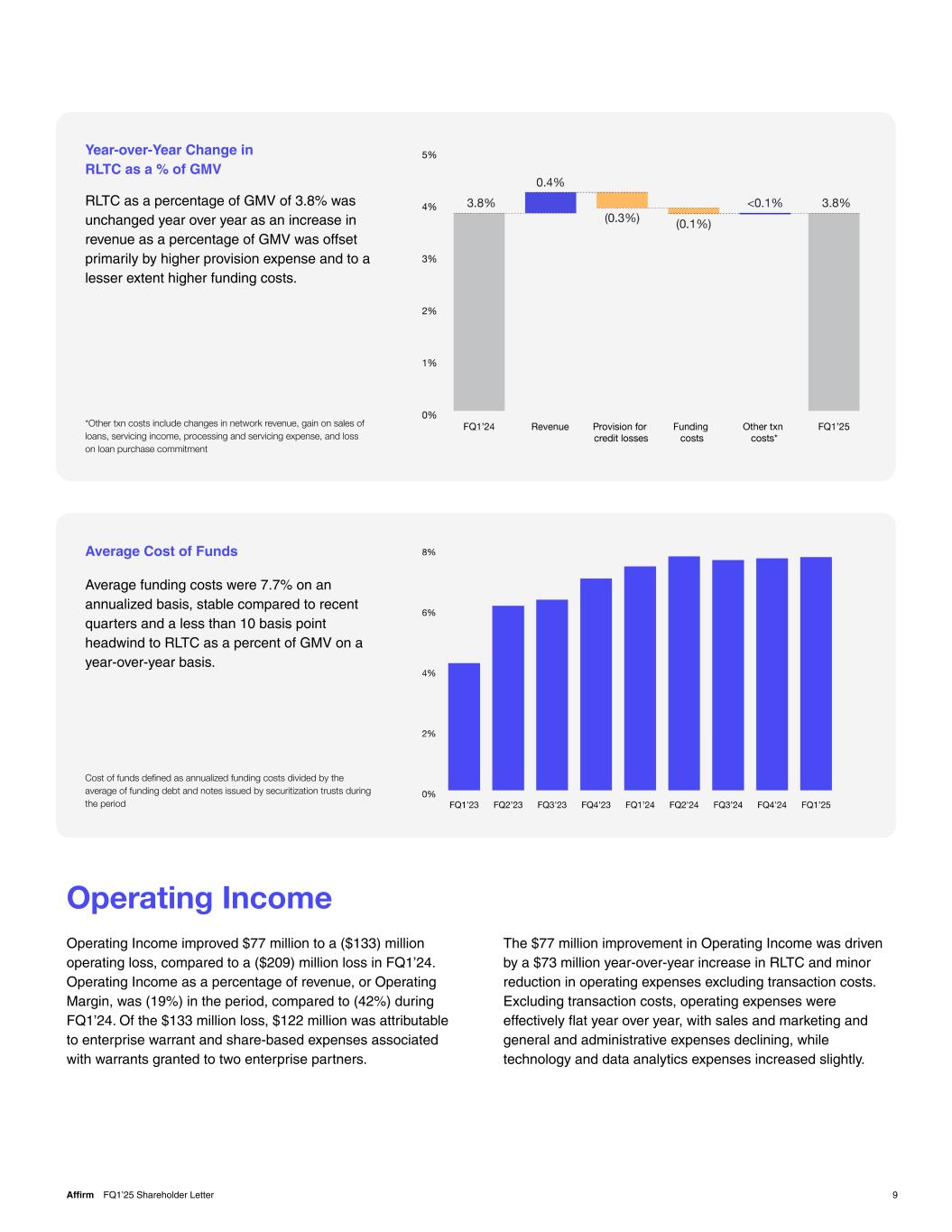
9Affirm FQ1’25 Shareholder Letter Operating Income Operating Income improved $77 million to a ($133) million operating loss, compared to a ($209) million loss in FQ1’24. Operating Income as a percentage of revenue, or Operating Margin, was (19%) in the period, compared to (42%) during FQ1’24. Of the $133 million loss, $122 million was attributable to enterprise warrant and share-based expenses associated with warrants granted to two enterprise partners. The $77 million improvement in Operating Income was driven by a $73 million year-over-year increase in RLTC and minor reduction in operating expenses excluding transaction costs. Excluding transaction costs, operating expenses were effectively flat year over year, with sales and marketing and general and administrative expenses declining, while technology and data analytics expenses increased slightly. Average Cost of Funds Average funding costs were 7.7% on an annualized basis, stable compared to recent quarters and a less than 10 basis point headwind to RLTC as a percent of GMV on a year-over-year basis. *Other txn costs include changes in network revenue, gain on sales of loans, servicing income, processing and servicing expense, and loss on loan purchase commitment Year-over-Year Change in RLTC as a % of GMV Cost of funds defined as annualized funding costs divided by the average of funding debt and notes issued by securitization trusts during the period RLTC as a percentage of GMV of 3.8% was unchanged year over year as an increase in revenue as a percentage of GMV was offset primarily by higher provision expense and to a lesser extent higher funding costs.
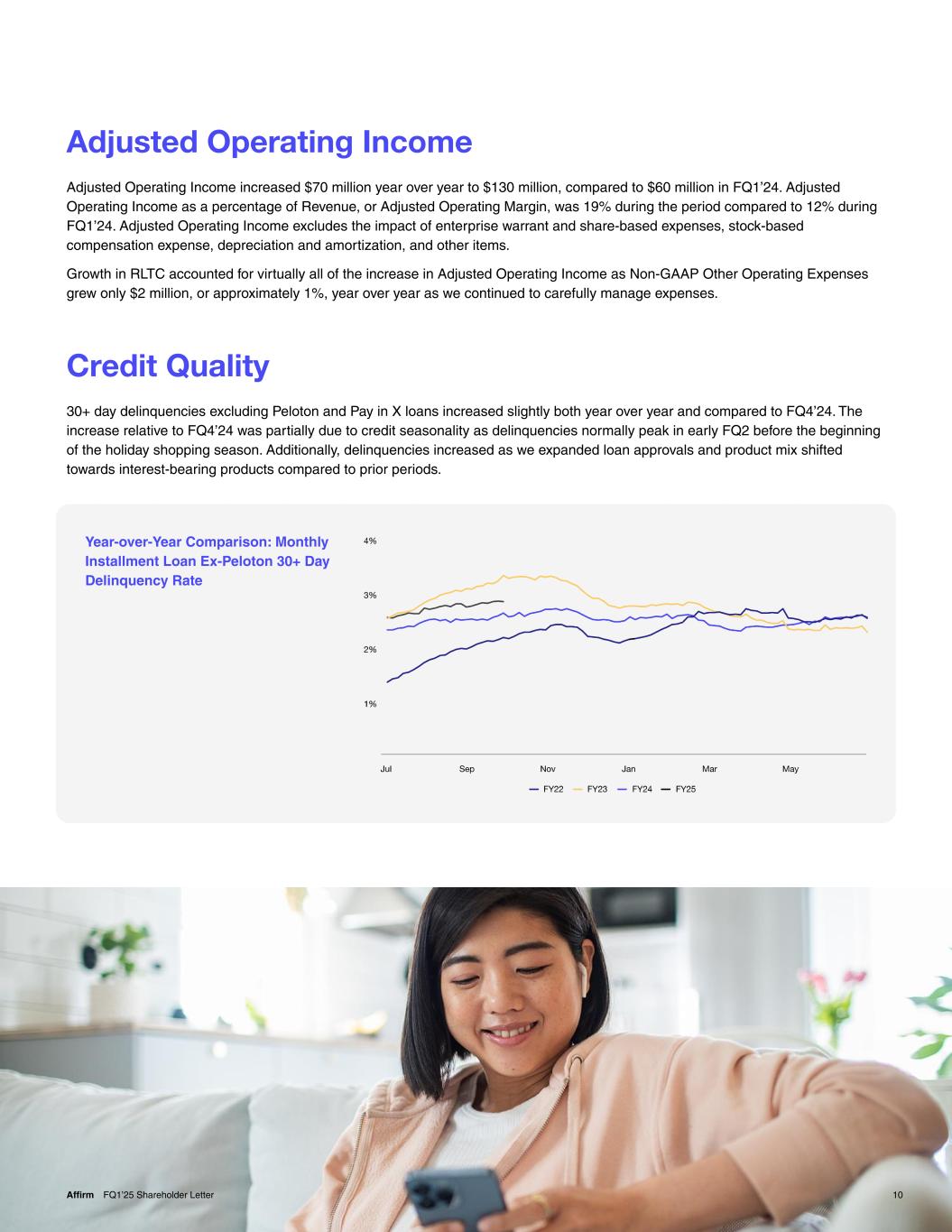
10Affirm FQ1’25 Shareholder Letter Credit Quality 30+ day delinquencies excluding Peloton and Pay in X loans increased slightly both year over year and compared to FQ4’24. The increase relative to FQ4’24 was partially due to credit seasonality as delinquencies normally peak in early FQ2 before the beginning of the holiday shopping season. Additionally, delinquencies increased as we expanded loan approvals and product mix shifted towards interest-bearing products compared to prior periods. Year-over-Year Comparison: Monthly Installment Loan Ex-Peloton 30+ Day Delinquency Rate Adjusted Operating Income Adjusted Operating Income increased $70 million year over year to $130 million, compared to $60 million in FQ1’24. Adjusted Operating Income as a percentage of Revenue, or Adjusted Operating Margin, was 19% during the period compared to 12% during FQ1’24. Adjusted Operating Income excludes the impact of enterprise warrant and share-based expenses, stock-based compensation expense, depreciation and amortization, and other items. Growth in RLTC accounted for virtually all of the increase in Adjusted Operating Income as Non-GAAP Other Operating Expenses grew only $2 million, or approximately 1%, year over year as we continued to carefully manage expenses.
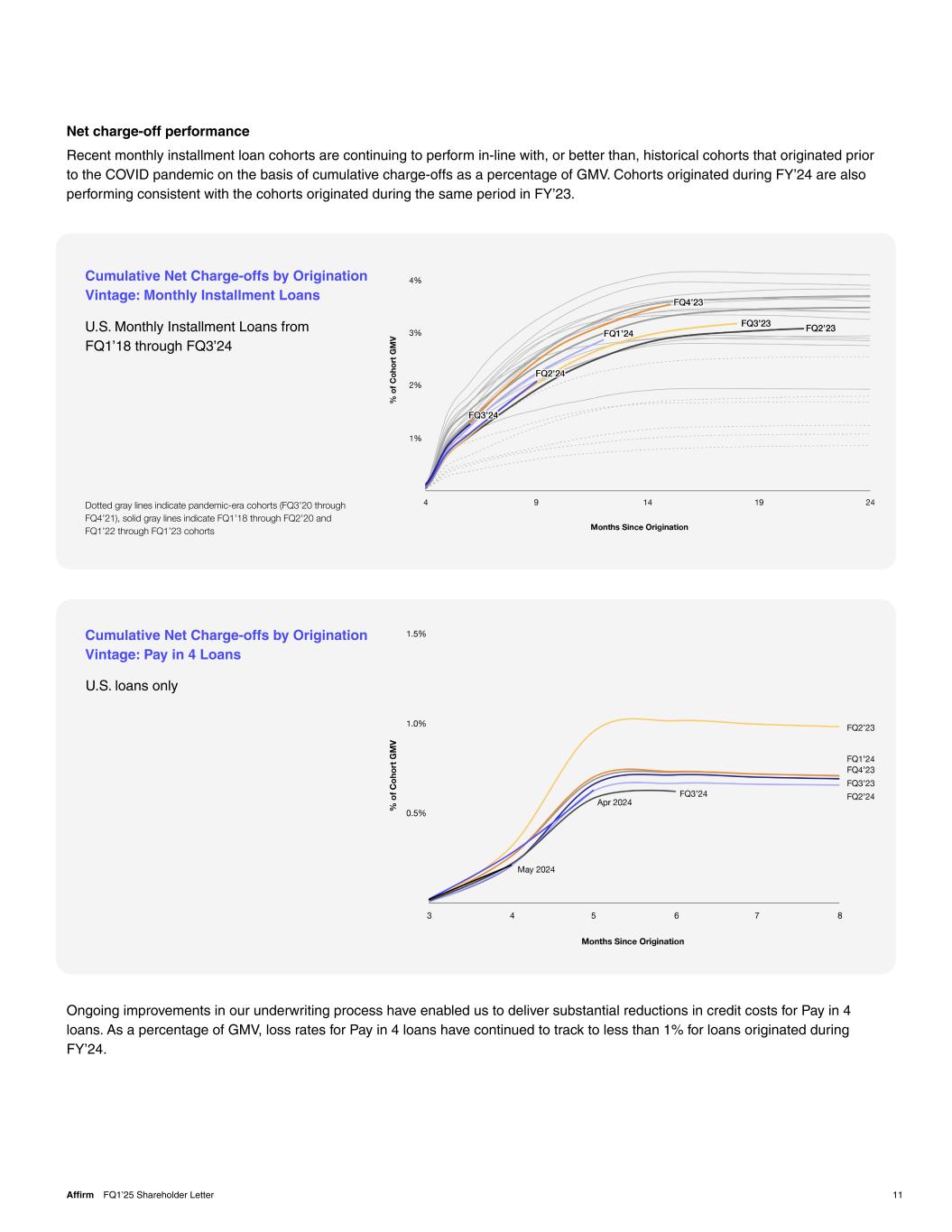
11Affirm FQ1’25 Shareholder Letter Dotted gray lines indicate pandemic-era cohorts (FQ3’20 through FQ4’21), solid gray lines indicate FQ1’18 through FQ2’20 and FQ1’22 through FQ1’23 cohorts Ongoing improvements in our underwriting process have enabled us to deliver substantial reductions in credit costs for Pay in 4 loans. As a percentage of GMV, loss rates for Pay in 4 loans have continued to track to less than 1% for loans originated during FY’24. U.S. loans only Net charge-off performance Recent monthly installment loan cohorts are continuing to perform in-line with, or better than, historical cohorts that originated prior to the COVID pandemic on the basis of cumulative charge-offs as a percentage of GMV. Cohorts originated during FY’24 are also performing consistent with the cohorts originated during the same period in FY’23. Cumulative Net Charge-offs by Origination Vintage: Monthly Installment Loans U.S. Monthly Installment Loans from FQ1’18 through FQ3’24 Cumulative Net Charge-offs by Origination Vintage: Pay in 4 Loans
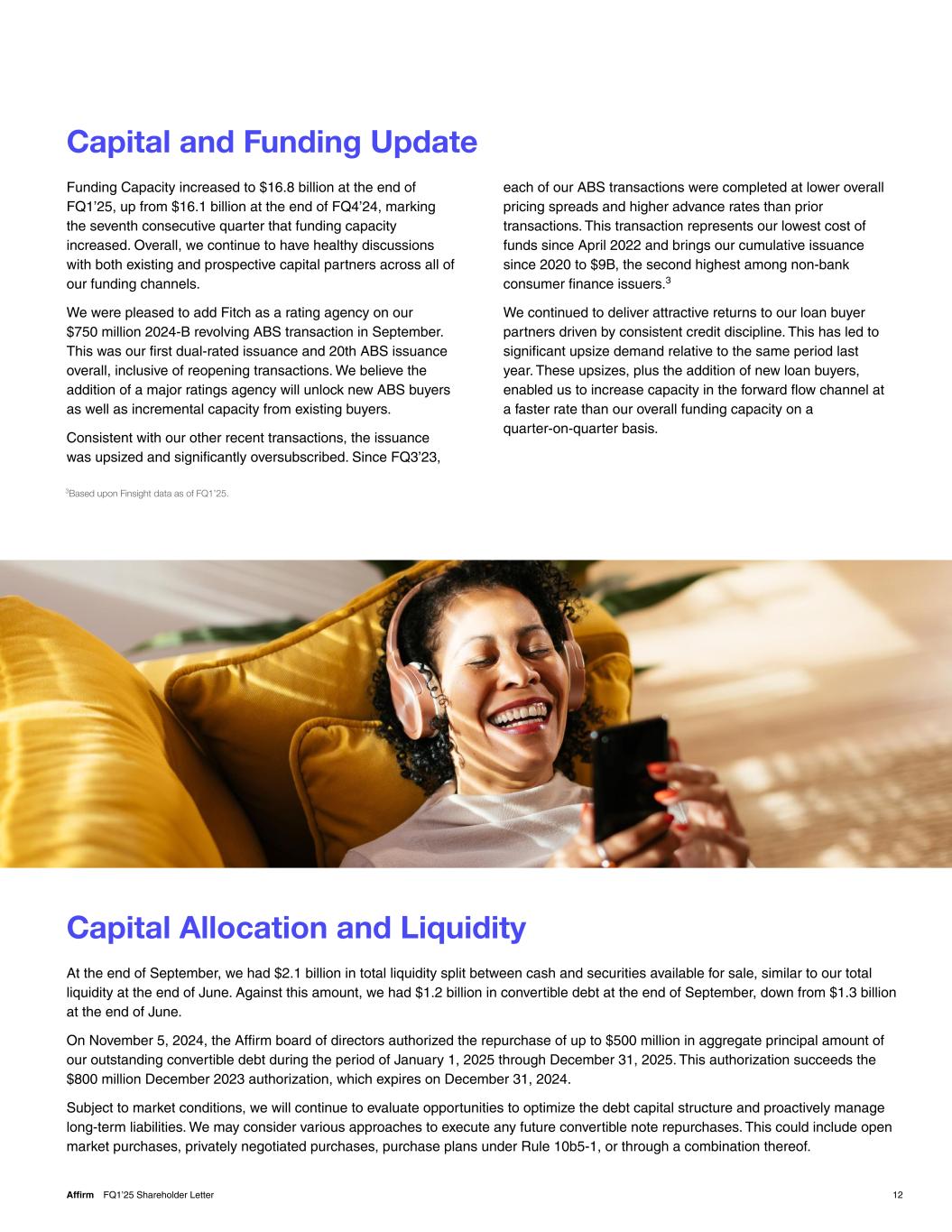
12Affirm FQ1’25 Shareholder Letter Capital and Funding Update Funding Capacity increased to $16.8 billion at the end of FQ1’25, up from $16.1 billion at the end of FQ4’24, marking the seventh consecutive quarter that funding capacity increased. Overall, we continue to have healthy discussions with both existing and prospective capital partners across all of our funding channels. We were pleased to add Fitch as a rating agency on our $750 million 2024-B revolving ABS transaction in September. This was our first dual-rated issuance and 20th ABS issuance overall, inclusive of reopening transactions. We believe the addition of a major ratings agency will unlock new ABS buyers as well as incremental capacity from existing buyers. Consistent with our other recent transactions, the issuance was upsized and significantly oversubscribed. Since FQ3’23, Capital Allocation and Liquidity each of our ABS transactions were completed at lower overall pricing spreads and higher advance rates than prior transactions. This transaction represents our lowest cost of funds since April 2022 and brings our cumulative issuance since 2020 to $9B, the second highest among non-bank consumer finance issuers.3 We continued to deliver attractive returns to our loan buyer partners driven by consistent credit discipline. This has led to significant upsize demand relative to the same period last year. These upsizes, plus the addition of new loan buyers, enabled us to increase capacity in the forward flow channel at a faster rate than our overall funding capacity on a quarter-on-quarter basis. At the end of September, we had $2.1 billion in total liquidity split between cash and securities available for sale, similar to our total liquidity at the end of June. Against this amount, we had $1.2 billion in convertible debt at the end of September, down from $1.3 billion at the end of June. On November 5, 2024, the Affirm board of directors authorized the repurchase of up to $500 million in aggregate principal amount of our outstanding convertible debt during the period of January 1, 2025 through December 31, 2025. This authorization succeeds the $800 million December 2023 authorization, which expires on December 31, 2024. Subject to market conditions, we will continue to evaluate opportunities to optimize the debt capital structure and proactively manage long-term liabilities. We may consider various approaches to execute any future convertible note repurchases. This could include open market purchases, privately negotiated purchases, purchase plans under Rule 10b5-1, or through a combination thereof. 3Based upon Finsight data as of FQ1’25.
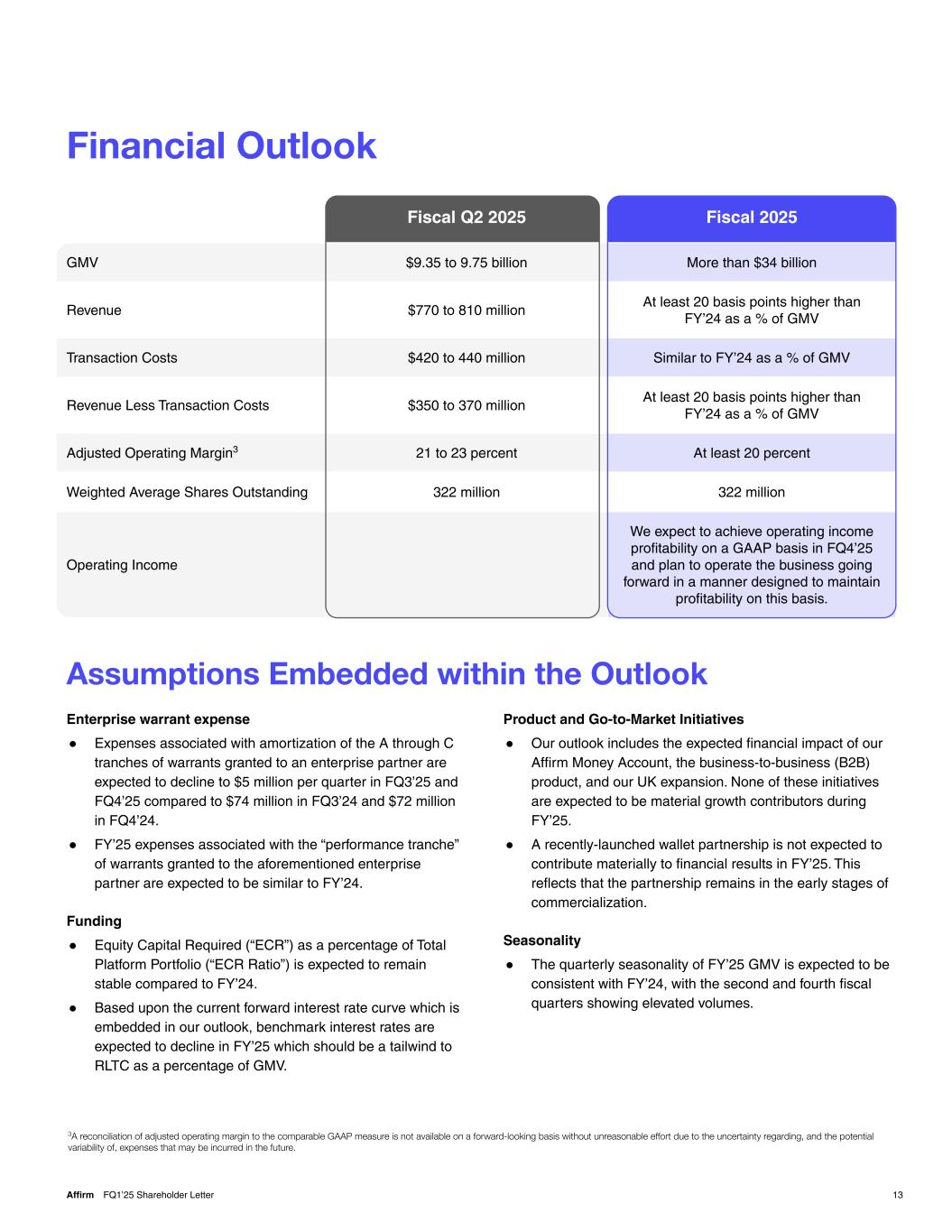
Financial Outlook 13Affirm FQ1’25 Shareholder Letter Assumptions Embedded within the Outlook Product and Go-to-Market Initiatives ● Our outlook includes the expected financial impact of our Affirm Money Account, the business-to-business (B2B) product, and our UK expansion. None of these initiatives are expected to be material growth contributors during FY’25. ● A recently-launched wallet partnership is not expected to contribute materially to financial results in FY’25. This reflects that the partnership remains in the early stages of commercialization. Seasonality ● The quarterly seasonality of FY’25 GMV is expected to be consistent with FY’24, with the second and fourth fiscal quarters showing elevated volumes. Fiscal Q2 2025 Fiscal 2025 GMV $9.35 to 9.75 billion More than $34 billion Revenue $770 to 810 million At least 20 basis points higher than FY’24 as a % of GMV Transaction Costs $420 to 440 million Similar to FY’24 as a % of GMV Revenue Less Transaction Costs $350 to 370 million At least 20 basis points higher than FY’24 as a % of GMV Adjusted Operating Margin3 21 to 23 percent At least 20 percent Weighted Average Shares Outstanding 322 million 322 million Operating Income We expect to achieve operating income profitability on a GAAP basis in FQ4’25 and plan to operate the business going forward in a manner designed to maintain profitability on this basis. 3A reconciliation of adjusted operating margin to the comparable GAAP measure is not available on a forward-looking basis without unreasonable effort due to the uncertainty regarding, and the potential variability of, expenses that may be incurred in the future. Enterprise warrant expense ● Expenses associated with amortization of the A through C tranches of warrants granted to an enterprise partner are expected to decline to $5 million per quarter in FQ3’25 and FQ4’25 compared to $74 million in FQ3’24 and $72 million in FQ4’24. ● FY’25 expenses associated with the “performance tranche” of warrants granted to the aforementioned enterprise partner are expected to be similar to FY’24. Funding ● Equity Capital Required (“ECR”) as a percentage of Total Platform Portfolio (“ECR Ratio”) is expected to remain stable compared to FY’24. ● Based upon the current forward interest rate curve which is embedded in our outlook, benchmark interest rates are expected to decline in FY’25 which should be a tailwind to RLTC as a percentage of GMV.
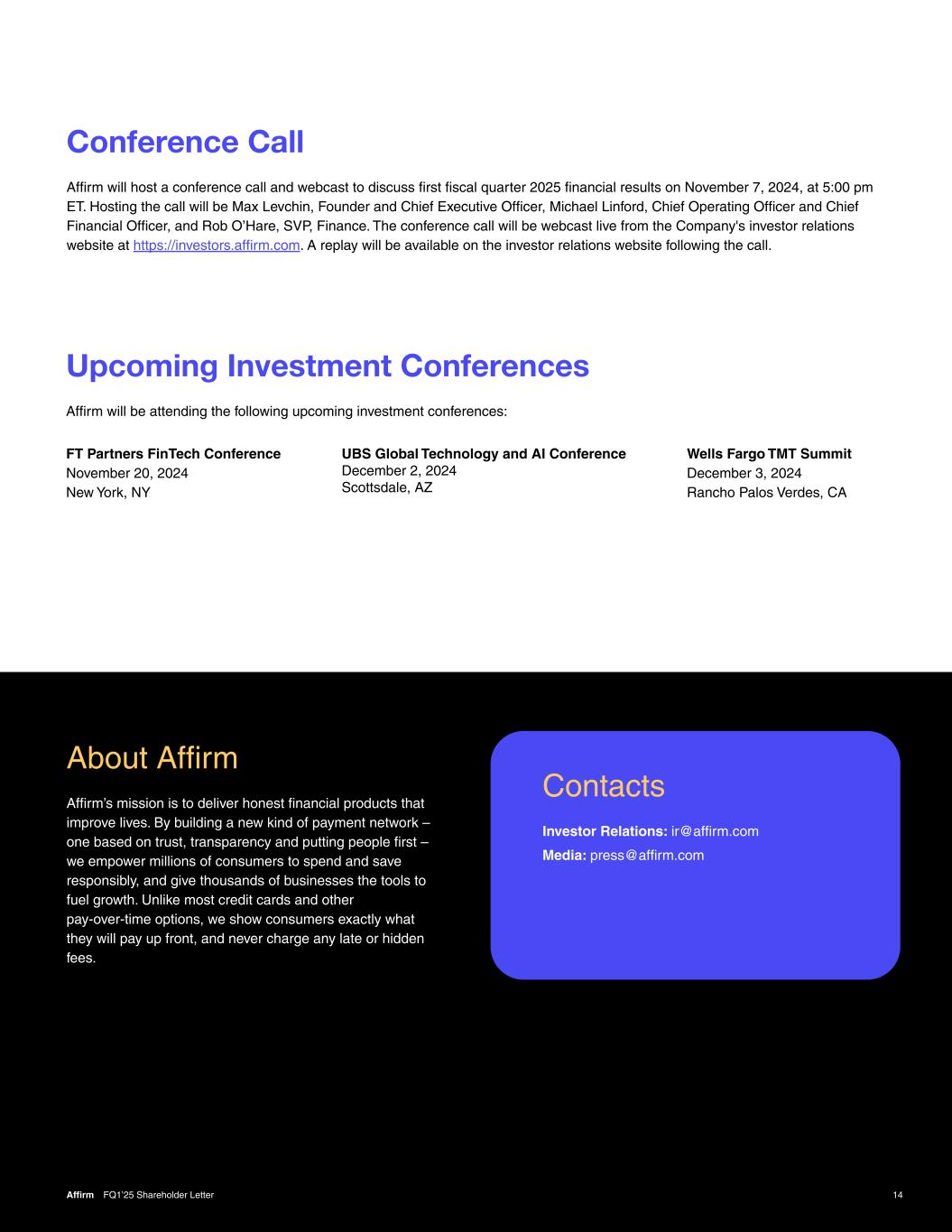
Conference Call 14Affirm FQ1’25 Shareholder Letter Affirm will host a conference call and webcast to discuss first fiscal quarter 2025 financial results on November 7, 2024, at 5:00 pm ET. Hosting the call will be Max Levchin, Founder and Chief Executive Officer, Michael Linford, Chief Operating Officer and Chief Financial Officer, and Rob O’Hare, SVP, Finance. The conference call will be webcast live from the Company's investor relations website at https://investors.affirm.com. A replay will be available on the investor relations website following the call. Upcoming Investment Conferences Affirm will be attending the following upcoming investment conferences: FT Partners FinTech Conference November 20, 2024 New York, NY UBS Global Technology and AI Conference December 2, 2024 Scottsdale, AZ About Affirm Affirm’s mission is to deliver honest financial products that improve lives. By building a new kind of payment network – one based on trust, transparency and putting people first – we empower millions of consumers to spend and save responsibly, and give thousands of businesses the tools to fuel growth. Unlike most credit cards and other pay-over-time options, we show consumers exactly what they will pay up front, and never charge any late or hidden fees. Contacts Investor Relations: ir@affirm.com Media: press@affirm.com Wells Fargo TMT Summit December 3, 2024 Rancho Palos Verdes, CA
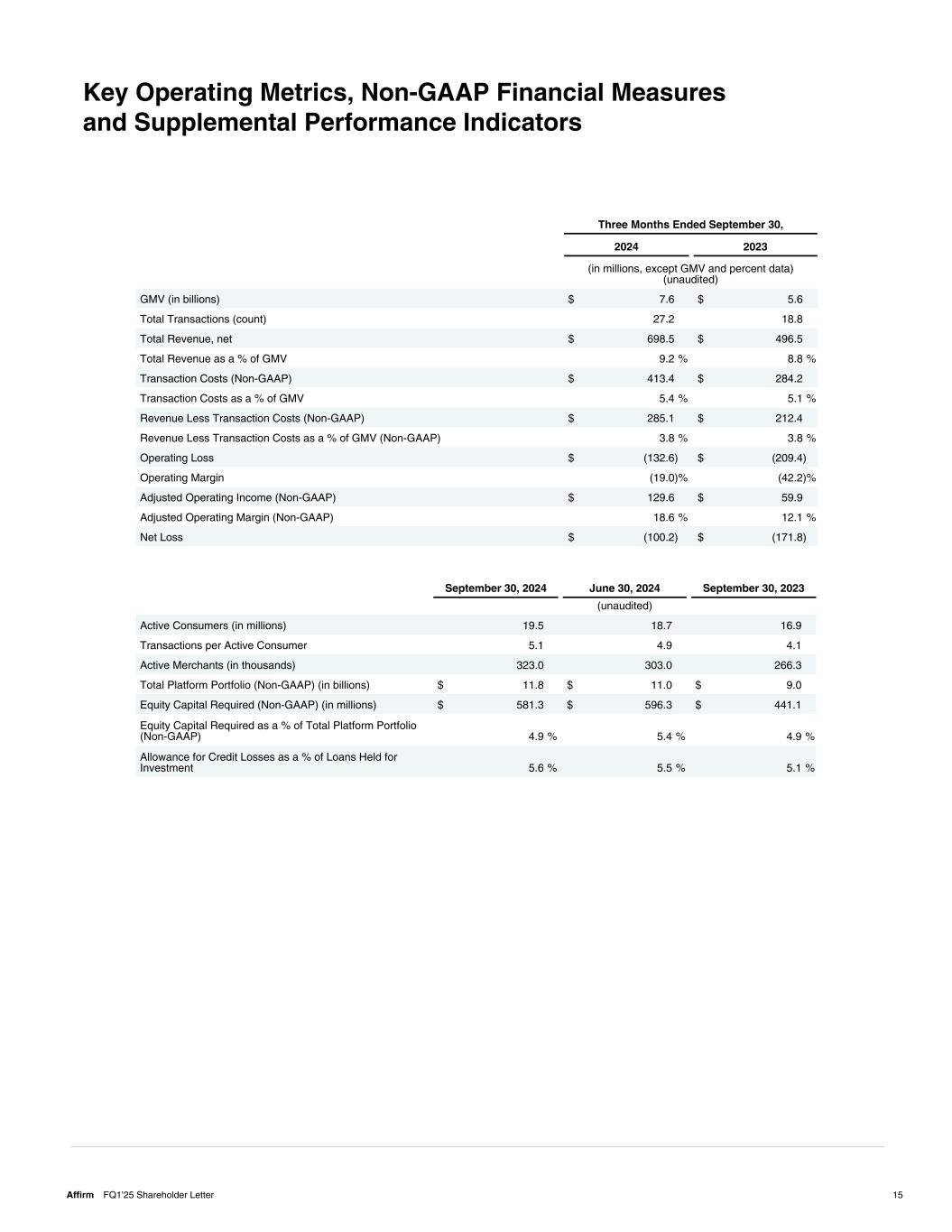
Three Months Ended September 30, 2024 2023 (in millions, except GMV and percent data) (unaudited) GMV (in billions) $ 7.6 $ 5.6 Total Transactions (count) 27.2 18.8 Total Revenue, net $ 698.5 $ 496.5 Total Revenue as a % of GMV 9.2 % 8.8 % Transaction Costs (Non-GAAP) $ 413.4 $ 284.2 Transaction Costs as a % of GMV 5.4 % 5.1 % Revenue Less Transaction Costs (Non-GAAP) $ 285.1 $ 212.4 Revenue Less Transaction Costs as a % of GMV (Non-GAAP) 3.8 % 3.8 % Operating Loss $ (132.6) $ (209.4) Operating Margin (19.0) % (42.2) % Adjusted Operating Income (Non-GAAP) $ 129.6 $ 59.9 Adjusted Operating Margin (Non-GAAP) 18.6 % 12.1 % Net Loss $ (100.2) $ (171.8) Key Operating Metrics, Non-GAAP Financial Measures and Supplemental Performance Indicators September 30, 2024 June 30, 2024 September 30, 2023 (unaudited) Active Consumers (in millions) 19.5 18.7 16.9 Transactions per Active Consumer 5.1 4.9 4.1 Active Merchants (in thousands) 323.0 303.0 266.3 Total Platform Portfolio (Non-GAAP) (in billions) $ 11.8 $ 11.0 $ 9.0 Equity Capital Required (Non-GAAP) (in millions) $ 581.3 $ 596.3 $ 441.1 Equity Capital Required as a % of Total Platform Portfolio (Non-GAAP) 4.9 % 5.4 % 4.9 % Allowance for Credit Losses as a % of Loans Held for Investment 5.6 % 5.5 % 5.1 % Affirm FQ1’25 Shareholder Letter 15
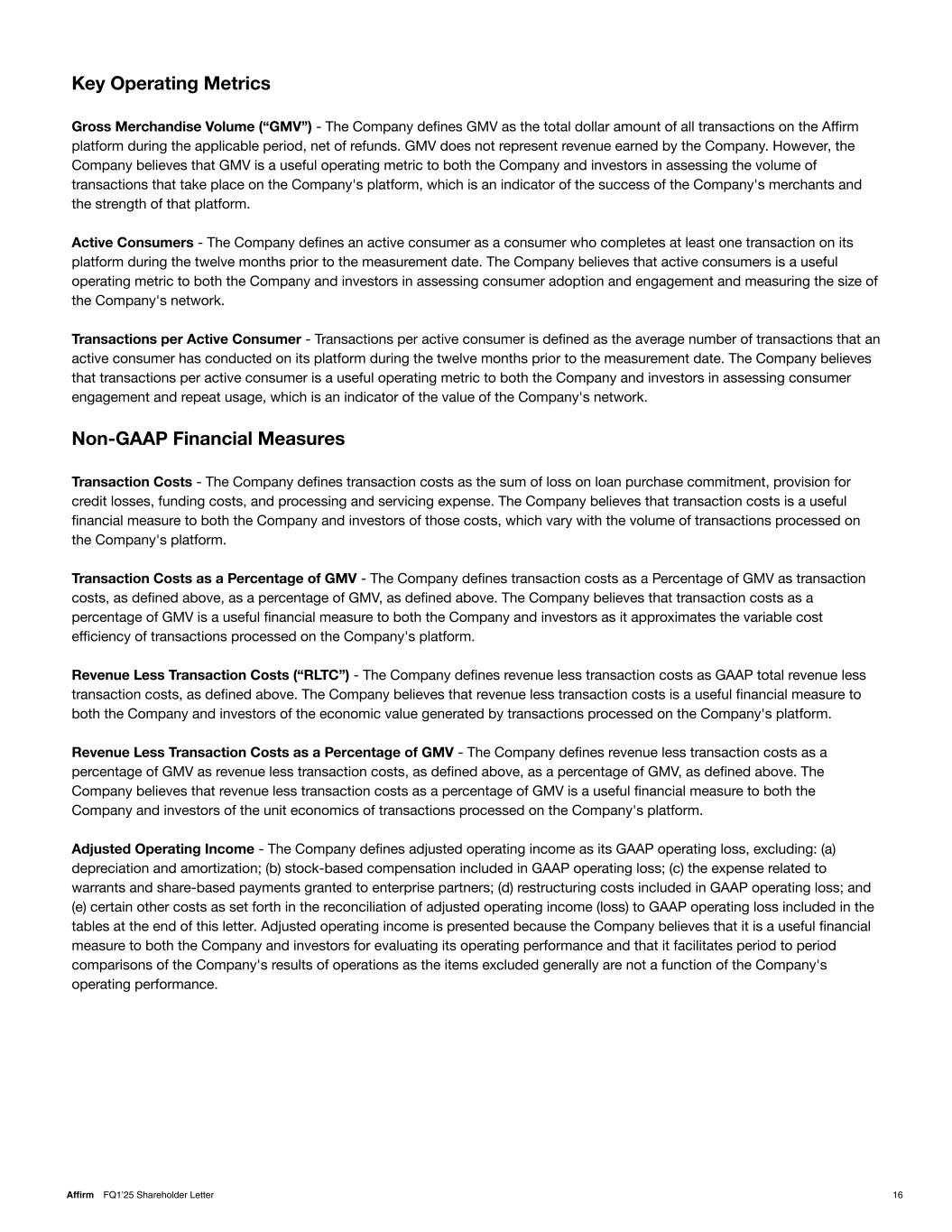
Key Operating Metrics Gross Merchandise Volume (“GMV”) - The Company defines GMV as the total dollar amount of all transactions on the Affirm platform during the applicable period, net of refunds. GMV does not represent revenue earned by the Company. However, the Company believes that GMV is a useful operating metric to both the Company and investors in assessing the volume of transactions that take place on the Company's platform, which is an indicator of the success of the Company's merchants and the strength of that platform. Active Consumers - The Company defines an active consumer as a consumer who completes at least one transaction on its platform during the twelve months prior to the measurement date. The Company believes that active consumers is a useful operating metric to both the Company and investors in assessing consumer adoption and engagement and measuring the size of the Company's network. Transactions per Active Consumer - Transactions per active consumer is defined as the average number of transactions that an active consumer has conducted on its platform during the twelve months prior to the measurement date. The Company believes that transactions per active consumer is a useful operating metric to both the Company and investors in assessing consumer engagement and repeat usage, which is an indicator of the value of the Company's network. Non-GAAP Financial Measures Transaction Costs - The Company defines transaction costs as the sum of loss on loan purchase commitment, provision for credit losses, funding costs, and processing and servicing expense. The Company believes that transaction costs is a useful financial measure to both the Company and investors of those costs, which vary with the volume of transactions processed on the Company's platform. Transaction Costs as a Percentage of GMV - The Company defines transaction costs as a Percentage of GMV as transaction costs, as defined above, as a percentage of GMV, as defined above. The Company believes that transaction costs as a percentage of GMV is a useful financial measure to both the Company and investors as it approximates the variable cost efficiency of transactions processed on the Company's platform. Revenue Less Transaction Costs (“RLTC”) - The Company defines revenue less transaction costs as GAAP total revenue less transaction costs, as defined above. The Company believes that revenue less transaction costs is a useful financial measure to both the Company and investors of the economic value generated by transactions processed on the Company's platform. Revenue Less Transaction Costs as a Percentage of GMV - The Company defines revenue less transaction costs as a percentage of GMV as revenue less transaction costs, as defined above, as a percentage of GMV, as defined above. The Company believes that revenue less transaction costs as a percentage of GMV is a useful financial measure to both the Company and investors of the unit economics of transactions processed on the Company's platform. Adjusted Operating Income - The Company defines adjusted operating income as its GAAP operating loss, excluding: (a) depreciation and amortization; (b) stock-based compensation included in GAAP operating loss; (c) the expense related to warrants and share-based payments granted to enterprise partners; (d) restructuring costs included in GAAP operating loss; and (e) certain other costs as set forth in the reconciliation of adjusted operating income (loss) to GAAP operating loss included in the tables at the end of this letter. Adjusted operating income is presented because the Company believes that it is a useful financial measure to both the Company and investors for evaluating its operating performance and that it facilitates period to period comparisons of the Company's results of operations as the items excluded generally are not a function of the Company's operating performance. Affirm FQ1’25 Shareholder Letter 16
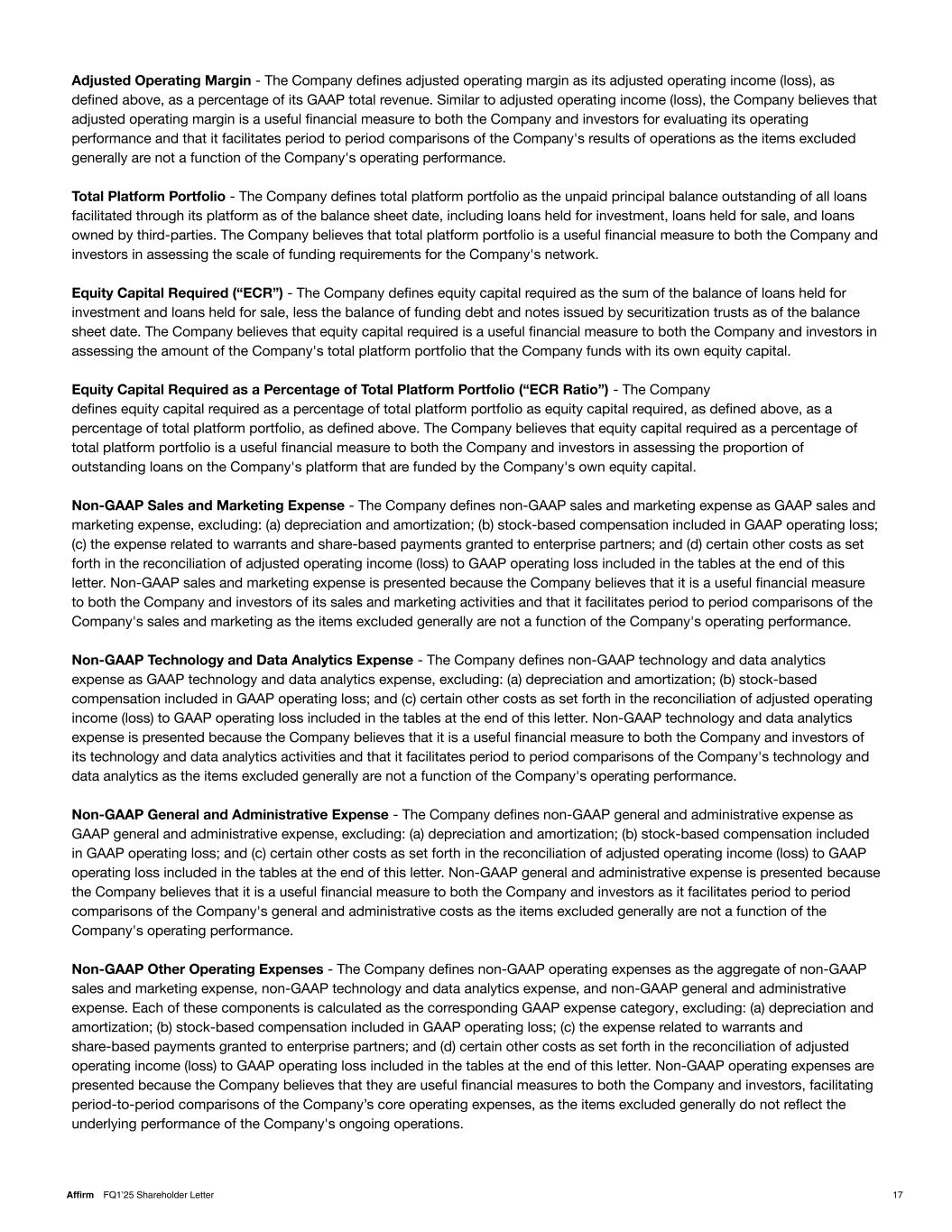
Adjusted Operating Margin - The Company defines adjusted operating margin as its adjusted operating income (loss), as defined above, as a percentage of its GAAP total revenue. Similar to adjusted operating income (loss), the Company believes that adjusted operating margin is a useful financial measure to both the Company and investors for evaluating its operating performance and that it facilitates period to period comparisons of the Company's results of operations as the items excluded generally are not a function of the Company's operating performance. Total Platform Portfolio - The Company defines total platform portfolio as the unpaid principal balance outstanding of all loans facilitated through its platform as of the balance sheet date, including loans held for investment, loans held for sale, and loans owned by third-parties. The Company believes that total platform portfolio is a useful financial measure to both the Company and investors in assessing the scale of funding requirements for the Company's network. Equity Capital Required (“ECR”) - The Company defines equity capital required as the sum of the balance of loans held for investment and loans held for sale, less the balance of funding debt and notes issued by securitization trusts as of the balance sheet date. The Company believes that equity capital required is a useful financial measure to both the Company and investors in assessing the amount of the Company's total platform portfolio that the Company funds with its own equity capital. Equity Capital Required as a Percentage of Total Platform Portfolio (“ECR Ratio”) - The Company defines equity capital required as a percentage of total platform portfolio as equity capital required, as defined above, as a percentage of total platform portfolio, as defined above. The Company believes that equity capital required as a percentage of total platform portfolio is a useful financial measure to both the Company and investors in assessing the proportion of outstanding loans on the Company's platform that are funded by the Company's own equity capital. Non-GAAP Sales and Marketing Expense - The Company defines non-GAAP sales and marketing expense as GAAP sales and marketing expense, excluding: (a) depreciation and amortization; (b) stock-based compensation included in GAAP operating loss; (c) the expense related to warrants and share-based payments granted to enterprise partners; and (d) certain other costs as set forth in the reconciliation of adjusted operating income (loss) to GAAP operating loss included in the tables at the end of this letter. Non-GAAP sales and marketing expense is presented because the Company believes that it is a useful financial measure to both the Company and investors of its sales and marketing activities and that it facilitates period to period comparisons of the Company's sales and marketing as the items excluded generally are not a function of the Company's operating performance. Non-GAAP Technology and Data Analytics Expense - The Company defines non-GAAP technology and data analytics expense as GAAP technology and data analytics expense, excluding: (a) depreciation and amortization; (b) stock-based compensation included in GAAP operating loss; and (c) certain other costs as set forth in the reconciliation of adjusted operating income (loss) to GAAP operating loss included in the tables at the end of this letter. Non-GAAP technology and data analytics expense is presented because the Company believes that it is a useful financial measure to both the Company and investors of its technology and data analytics activities and that it facilitates period to period comparisons of the Company's technology and data analytics as the items excluded generally are not a function of the Company's operating performance. Non-GAAP General and Administrative Expense - The Company defines non-GAAP general and administrative expense as GAAP general and administrative expense, excluding: (a) depreciation and amortization; (b) stock-based compensation included in GAAP operating loss; and (c) certain other costs as set forth in the reconciliation of adjusted operating income (loss) to GAAP operating loss included in the tables at the end of this letter. Non-GAAP general and administrative expense is presented because the Company believes that it is a useful financial measure to both the Company and investors as it facilitates period to period comparisons of the Company's general and administrative costs as the items excluded generally are not a function of the Company's operating performance. Non-GAAP Other Operating Expenses - The Company defines non-GAAP operating expenses as the aggregate of non-GAAP sales and marketing expense, non-GAAP technology and data analytics expense, and non-GAAP general and administrative expense. Each of these components is calculated as the corresponding GAAP expense category, excluding: (a) depreciation and amortization; (b) stock-based compensation included in GAAP operating loss; (c) the expense related to warrants and share-based payments granted to enterprise partners; and (d) certain other costs as set forth in the reconciliation of adjusted operating income (loss) to GAAP operating loss included in the tables at the end of this letter. Non-GAAP operating expenses are presented because the Company believes that they are useful financial measures to both the Company and investors, facilitating period-to-period comparisons of the Company’s core operating expenses, as the items excluded generally do not reflect the underlying performance of the Company's ongoing operations. Affirm FQ1’25 Shareholder Letter 17
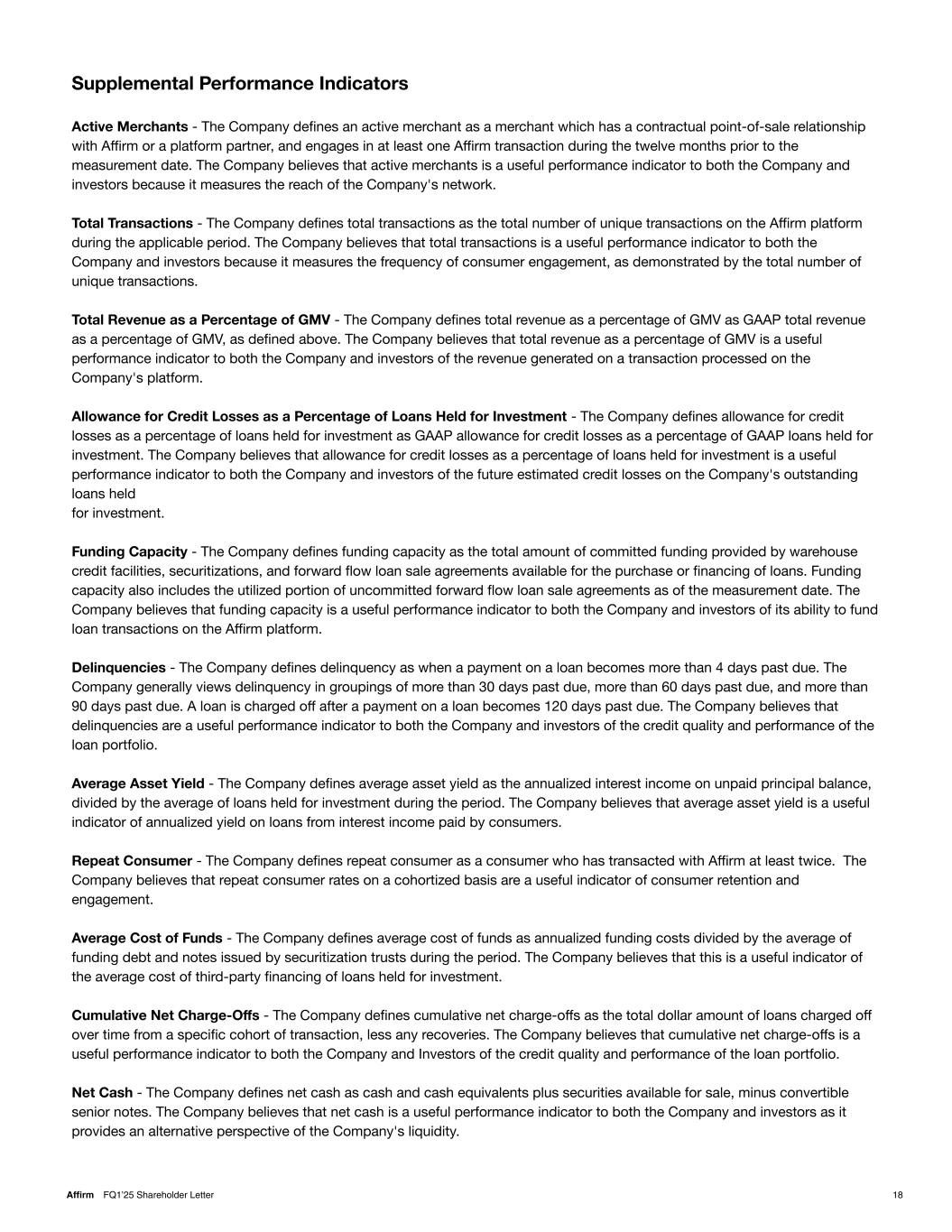
Supplemental Performance Indicators Active Merchants - The Company defines an active merchant as a merchant which has a contractual point-of-sale relationship with Affirm or a platform partner, and engages in at least one Affirm transaction during the twelve months prior to the measurement date. The Company believes that active merchants is a useful performance indicator to both the Company and investors because it measures the reach of the Company's network. Total Transactions - The Company defines total transactions as the total number of unique transactions on the Affirm platform during the applicable period. The Company believes that total transactions is a useful performance indicator to both the Company and investors because it measures the frequency of consumer engagement, as demonstrated by the total number of unique transactions. Total Revenue as a Percentage of GMV - The Company defines total revenue as a percentage of GMV as GAAP total revenue as a percentage of GMV, as defined above. The Company believes that total revenue as a percentage of GMV is a useful performance indicator to both the Company and investors of the revenue generated on a transaction processed on the Company's platform. Allowance for Credit Losses as a Percentage of Loans Held for Investment - The Company defines allowance for credit losses as a percentage of loans held for investment as GAAP allowance for credit losses as a percentage of GAAP loans held for investment. The Company believes that allowance for credit losses as a percentage of loans held for investment is a useful performance indicator to both the Company and investors of the future estimated credit losses on the Company's outstanding loans held for investment. Funding Capacity - The Company defines funding capacity as the total amount of committed funding provided by warehouse credit facilities, securitizations, and forward flow loan sale agreements available for the purchase or financing of loans. Funding capacity also includes the utilized portion of uncommitted forward flow loan sale agreements as of the measurement date. The Company believes that funding capacity is a useful performance indicator to both the Company and investors of its ability to fund loan transactions on the Affirm platform. Delinquencies - The Company defines delinquency as when a payment on a loan becomes more than 4 days past due. The Company generally views delinquency in groupings of more than 30 days past due, more than 60 days past due, and more than 90 days past due. A loan is charged off after a payment on a loan becomes 120 days past due. The Company believes that delinquencies are a useful performance indicator to both the Company and investors of the credit quality and performance of the loan portfolio. Average Asset Yield - The Company defines average asset yield as the annualized interest income on unpaid principal balance, divided by the average of loans held for investment during the period. The Company believes that average asset yield is a useful indicator of annualized yield on loans from interest income paid by consumers. Repeat Consumer - The Company defines repeat consumer as a consumer who has transacted with Affirm at least twice. The Company believes that repeat consumer rates on a cohortized basis are a useful indicator of consumer retention and engagement. Average Cost of Funds - The Company defines average cost of funds as annualized funding costs divided by the average of funding debt and notes issued by securitization trusts during the period. The Company believes that this is a useful indicator of the average cost of third-party financing of loans held for investment. Cumulative Net Charge-Offs - The Company defines cumulative net charge-offs as the total dollar amount of loans charged off over time from a specific cohort of transaction, less any recoveries. The Company believes that cumulative net charge-offs is a useful performance indicator to both the Company and Investors of the credit quality and performance of the loan portfolio. Net Cash - The Company defines net cash as cash and cash equivalents plus securities available for sale, minus convertible senior notes. The Company believes that net cash is a useful performance indicator to both the Company and investors as it provides an alternative perspective of the Company's liquidity. Affirm FQ1’25 Shareholder Letter 18
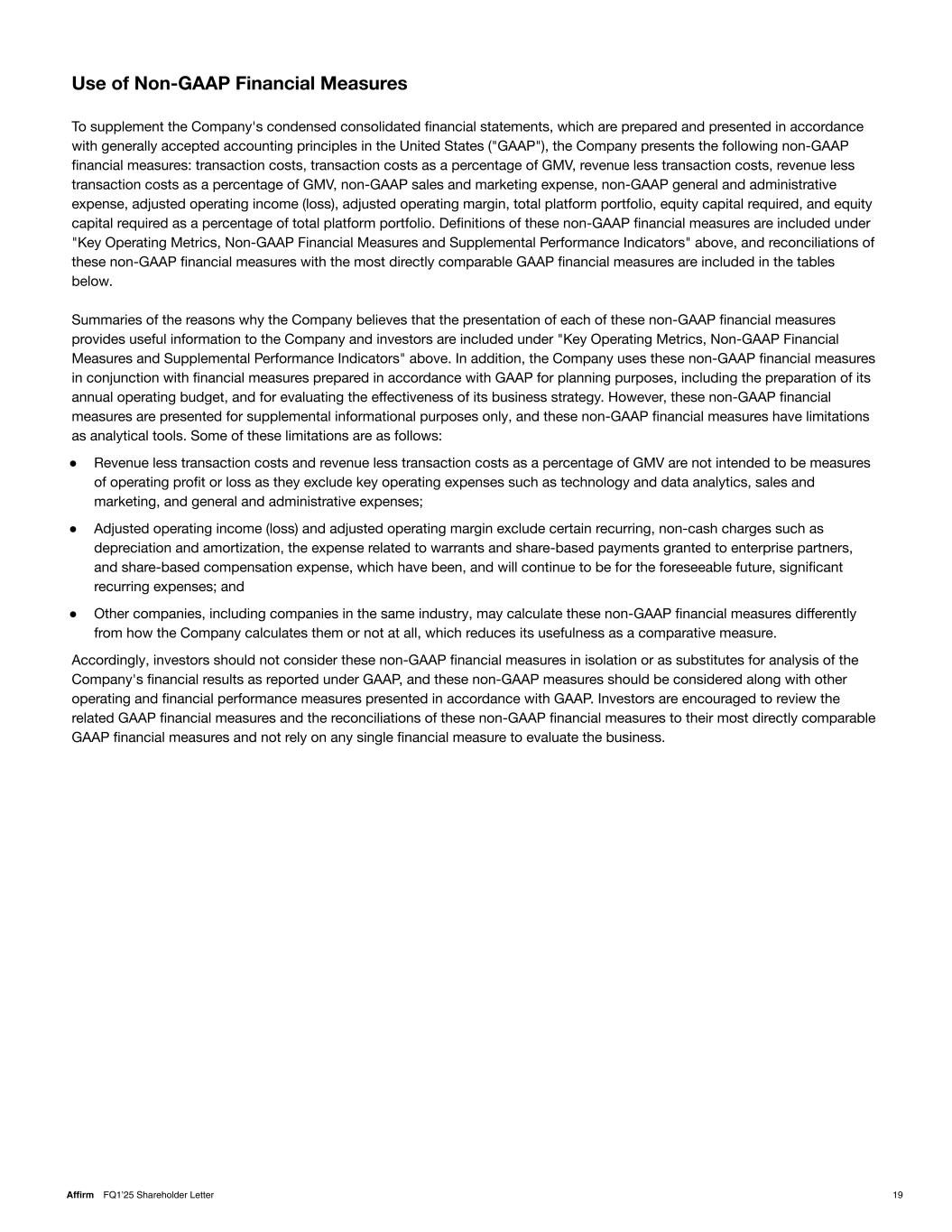
Use of Non-GAAP Financial Measures To supplement the Company's condensed consolidated financial statements, which are prepared and presented in accordance with generally accepted accounting principles in the United States ("GAAP"), the Company presents the following non-GAAP financial measures: transaction costs, transaction costs as a percentage of GMV, revenue less transaction costs, revenue less transaction costs as a percentage of GMV, non-GAAP sales and marketing expense, non-GAAP general and administrative expense, adjusted operating income (loss), adjusted operating margin, total platform portfolio, equity capital required, and equity capital required as a percentage of total platform portfolio. Definitions of these non-GAAP financial measures are included under "Key Operating Metrics, Non-GAAP Financial Measures and Supplemental Performance Indicators" above, and reconciliations of these non-GAAP financial measures with the most directly comparable GAAP financial measures are included in the tables below. Summaries of the reasons why the Company believes that the presentation of each of these non-GAAP financial measures provides useful information to the Company and investors are included under "Key Operating Metrics, Non-GAAP Financial Measures and Supplemental Performance Indicators" above. In addition, the Company uses these non-GAAP financial measures in conjunction with financial measures prepared in accordance with GAAP for planning purposes, including the preparation of its annual operating budget, and for evaluating the effectiveness of its business strategy. However, these non-GAAP financial measures are presented for supplemental informational purposes only, and these non-GAAP financial measures have limitations as analytical tools. Some of these limitations are as follows: ● Revenue less transaction costs and revenue less transaction costs as a percentage of GMV are not intended to be measures of operating profit or loss as they exclude key operating expenses such as technology and data analytics, sales and marketing, and general and administrative expenses; ● Adjusted operating income (loss) and adjusted operating margin exclude certain recurring, non-cash charges such as depreciation and amortization, the expense related to warrants and share-based payments granted to enterprise partners, and share-based compensation expense, which have been, and will continue to be for the foreseeable future, significant recurring expenses; and ● Other companies, including companies in the same industry, may calculate these non-GAAP financial measures differently from how the Company calculates them or not at all, which reduces its usefulness as a comparative measure. Accordingly, investors should not consider these non-GAAP financial measures in isolation or as substitutes for analysis of the Company's financial results as reported under GAAP, and these non-GAAP measures should be considered along with other operating and financial performance measures presented in accordance with GAAP. Investors are encouraged to review the related GAAP financial measures and the reconciliations of these non-GAAP financial measures to their most directly comparable GAAP financial measures and not rely on any single financial measure to evaluate the business. Affirm FQ1’25 Shareholder Letter 19
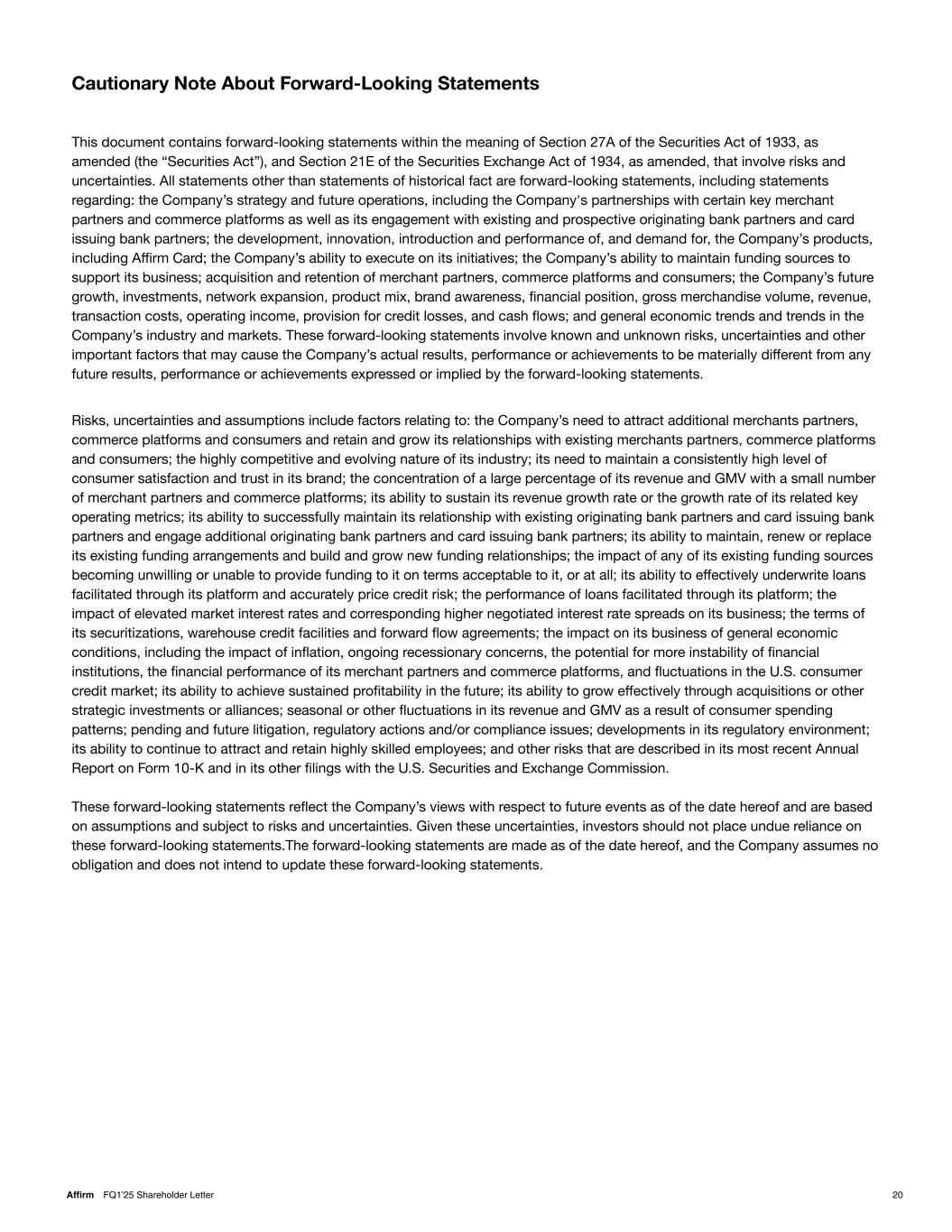
Cautionary Note About Forward-Looking Statements This document contains forward-looking statements within the meaning of Section 27A of the Securities Act of 1933, as amended (the “Securities Act”), and Section 21E of the Securities Exchange Act of 1934, as amended, that involve risks and uncertainties. All statements other than statements of historical fact are forward-looking statements, including statements regarding: the Company’s strategy and future operations, including the Company's partnerships with certain key merchant partners and commerce platforms as well as its engagement with existing and prospective originating bank partners and card issuing bank partners; the development, innovation, introduction and performance of, and demand for, the Company’s products, including Affirm Card; the Company’s ability to execute on its initiatives; the Company’s ability to maintain funding sources to support its business; acquisition and retention of merchant partners, commerce platforms and consumers; the Company’s future growth, investments, network expansion, product mix, brand awareness, financial position, gross merchandise volume, revenue, transaction costs, operating income, provision for credit losses, and cash flows; and general economic trends and trends in the Company’s industry and markets. These forward-looking statements involve known and unknown risks, uncertainties and other important factors that may cause the Company’s actual results, performance or achievements to be materially different from any future results, performance or achievements expressed or implied by the forward-looking statements. Risks, uncertainties and assumptions include factors relating to: the Company’s need to attract additional merchants partners, commerce platforms and consumers and retain and grow its relationships with existing merchants partners, commerce platforms and consumers; the highly competitive and evolving nature of its industry; its need to maintain a consistently high level of consumer satisfaction and trust in its brand; the concentration of a large percentage of its revenue and GMV with a small number of merchant partners and commerce platforms; its ability to sustain its revenue growth rate or the growth rate of its related key operating metrics; its ability to successfully maintain its relationship with existing originating bank partners and card issuing bank partners and engage additional originating bank partners and card issuing bank partners; its ability to maintain, renew or replace its existing funding arrangements and build and grow new funding relationships; the impact of any of its existing funding sources becoming unwilling or unable to provide funding to it on terms acceptable to it, or at all; its ability to effectively underwrite loans facilitated through its platform and accurately price credit risk; the performance of loans facilitated through its platform; the impact of elevated market interest rates and corresponding higher negotiated interest rate spreads on its business; the terms of its securitizations, warehouse credit facilities and forward flow agreements; the impact on its business of general economic conditions, including the impact of inflation, ongoing recessionary concerns, the potential for more instability of financial institutions, the financial performance of its merchant partners and commerce platforms, and fluctuations in the U.S. consumer credit market; its ability to achieve sustained profitability in the future; its ability to grow effectively through acquisitions or other strategic investments or alliances; seasonal or other fluctuations in its revenue and GMV as a result of consumer spending patterns; pending and future litigation, regulatory actions and/or compliance issues; developments in its regulatory environment; its ability to continue to attract and retain highly skilled employees; and other risks that are described in its most recent Annual Report on Form 10-K and in its other filings with the U.S. Securities and Exchange Commission. These forward-looking statements reflect the Company’s views with respect to future events as of the date hereof and are based on assumptions and subject to risks and uncertainties. Given these uncertainties, investors should not place undue reliance on these forward-looking statements.The forward-looking statements are made as of the date hereof, and the Company assumes no obligation and does not intend to update these forward-looking statements. Affirm FQ1’25 Shareholder Letter 20
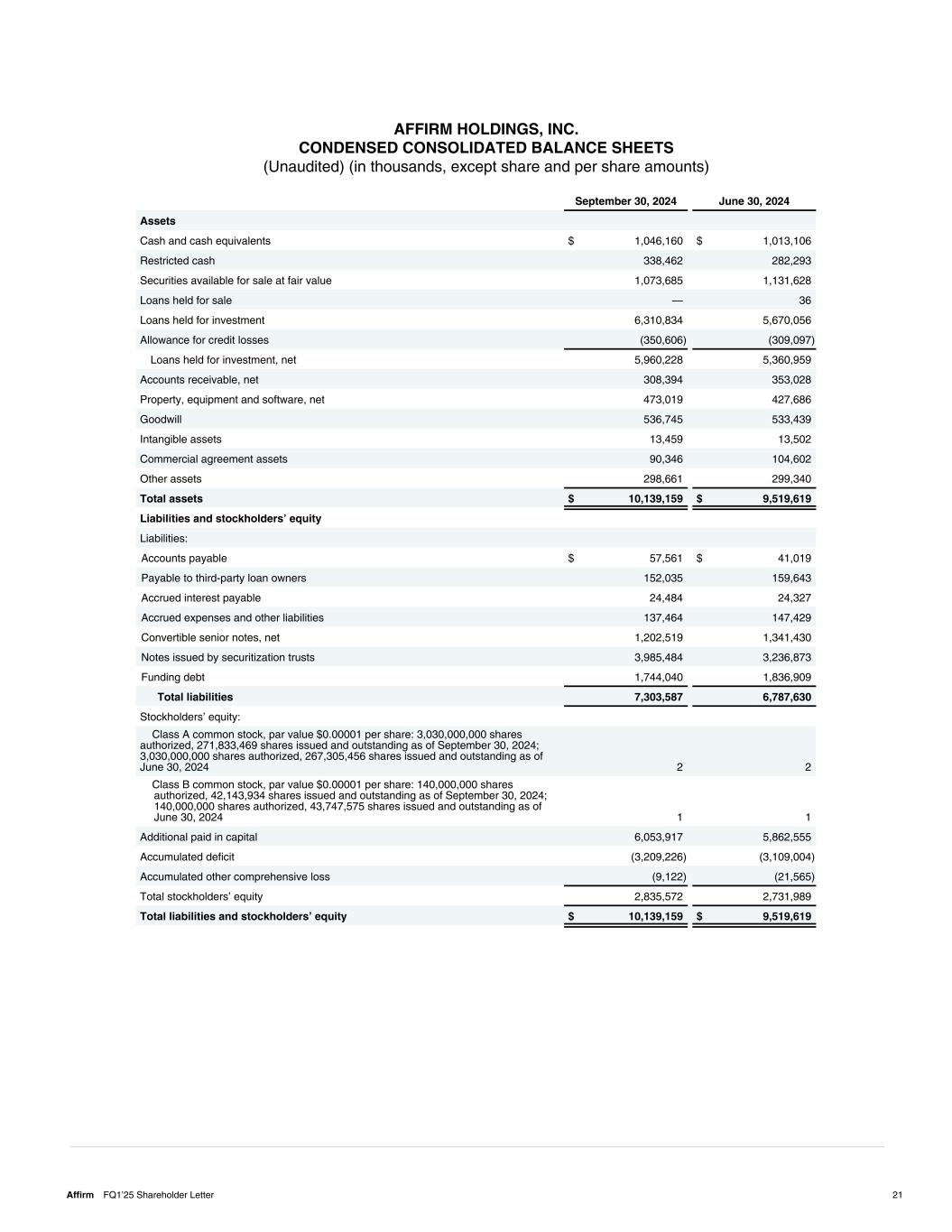
September 30, 2024 June 30, 2024 Assets Cash and cash equivalents $ 1,046,160 $ 1,013,106 Restricted cash 338,462 282,293 Securities available for sale at fair value 1,073,685 1,131,628 Loans held for sale — 36 Loans held for investment 6,310,834 5,670,056 Allowance for credit losses (350,606) (309,097) Loans held for investment, net 5,960,228 5,360,959 Accounts receivable, net 308,394 353,028 Property, equipment and software, net 473,019 427,686 Goodwill 536,745 533,439 Intangible assets 13,459 13,502 Commercial agreement assets 90,346 104,602 Other assets 298,661 299,340 Total assets $ 10,139,159 $ 9,519,619 Liabilities and stockholders’ equity Liabilities: Accounts payable $ 57,561 $ 41,019 Payable to third-party loan owners 152,035 159,643 Accrued interest payable 24,484 24,327 Accrued expenses and other liabilities 137,464 147,429 Convertible senior notes, net 1,202,519 1,341,430 Notes issued by securitization trusts 3,985,484 3,236,873 Funding debt 1,744,040 1,836,909 Total liabilities 7,303,587 6,787,630 Stockholders’ equity: Class A common stock, par value $0.00001 per share: 3,030,000,000 shares authorized, 271,833,469 shares issued and outstanding as of September 30, 2024; 3,030,000,000 shares authorized, 267,305,456 shares issued and outstanding as of June 30, 2024 2 2 Class B common stock, par value $0.00001 per share: 140,000,000 shares authorized, 42,143,934 shares issued and outstanding as of September 30, 2024; 140,000,000 shares authorized, 43,747,575 shares issued and outstanding as of June 30, 2024 1 1 Additional paid in capital 6,053,917 5,862,555 Accumulated deficit (3,209,226) (3,109,004) Accumulated other comprehensive loss (9,122) (21,565) Total stockholders’ equity 2,835,572 2,731,989 Total liabilities and stockholders’ equity $ 10,139,159 $ 9,519,619 AFFIRM HOLDINGS, INC. CONDENSED CONSOLIDATED BALANCE SHEETS (Unaudited) (in thousands, except share and per share amounts) Affirm FQ1’25 Shareholder Letter 21
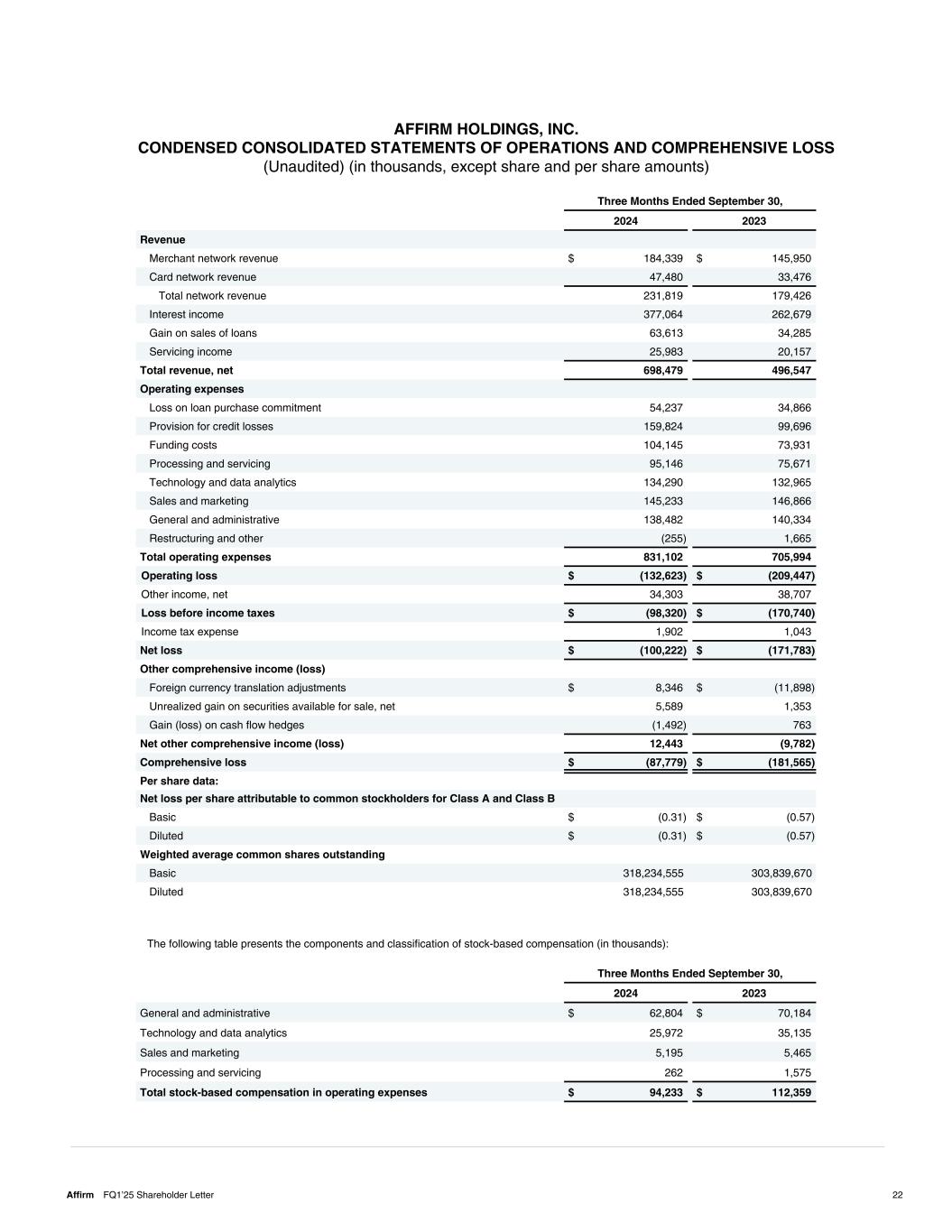
AFFIRM HOLDINGS, INC. CONDENSED CONSOLIDATED STATEMENTS OF OPERATIONS AND COMPREHENSIVE LOSS (Unaudited) (in thousands, except share and per share amounts) Three Months Ended September 30, 2024 2023 Revenue Merchant network revenue $ 184,339 $ 145,950 Card network revenue 47,480 33,476 Total network revenue 231,819 179,426 Interest income 377,064 262,679 Gain on sales of loans 63,613 34,285 Servicing income 25,983 20,157 Total revenue, net 698,479 496,547 Operating expenses Loss on loan purchase commitment 54,237 34,866 Provision for credit losses 159,824 99,696 Funding costs 104,145 73,931 Processing and servicing 95,146 75,671 Technology and data analytics 134,290 132,965 Sales and marketing 145,233 146,866 General and administrative 138,482 140,334 Restructuring and other (255) 1,665 Total operating expenses 831,102 705,994 Operating loss $ (132,623) $ (209,447) Other income, net 34,303 38,707 Loss before income taxes $ (98,320) $ (170,740) Income tax expense 1,902 1,043 Net loss $ (100,222) $ (171,783) Other comprehensive income (loss) Foreign currency translation adjustments $ 8,346 $ (11,898) Unrealized gain on securities available for sale, net 5,589 1,353 Gain (loss) on cash flow hedges (1,492) 763 Net other comprehensive income (loss) 12,443 (9,782) Comprehensive loss $ (87,779) $ (181,565) Per share data: Net loss per share attributable to common stockholders for Class A and Class B Basic $ (0.31) $ (0.57) Diluted $ (0.31) $ (0.57) Weighted average common shares outstanding Basic 318,234,555 303,839,670 Diluted 318,234,555 303,839,670 Three Months Ended September 30, 2024 2023 General and administrative $ 62,804 $ 70,184 Technology and data analytics 25,972 35,135 Sales and marketing 5,195 5,465 Processing and servicing 262 1,575 Total stock-based compensation in operating expenses $ 94,233 $ 112,359 The following table presents the components and classification of stock-based compensation (in thousands): Affirm FQ1’25 Shareholder Letter 22
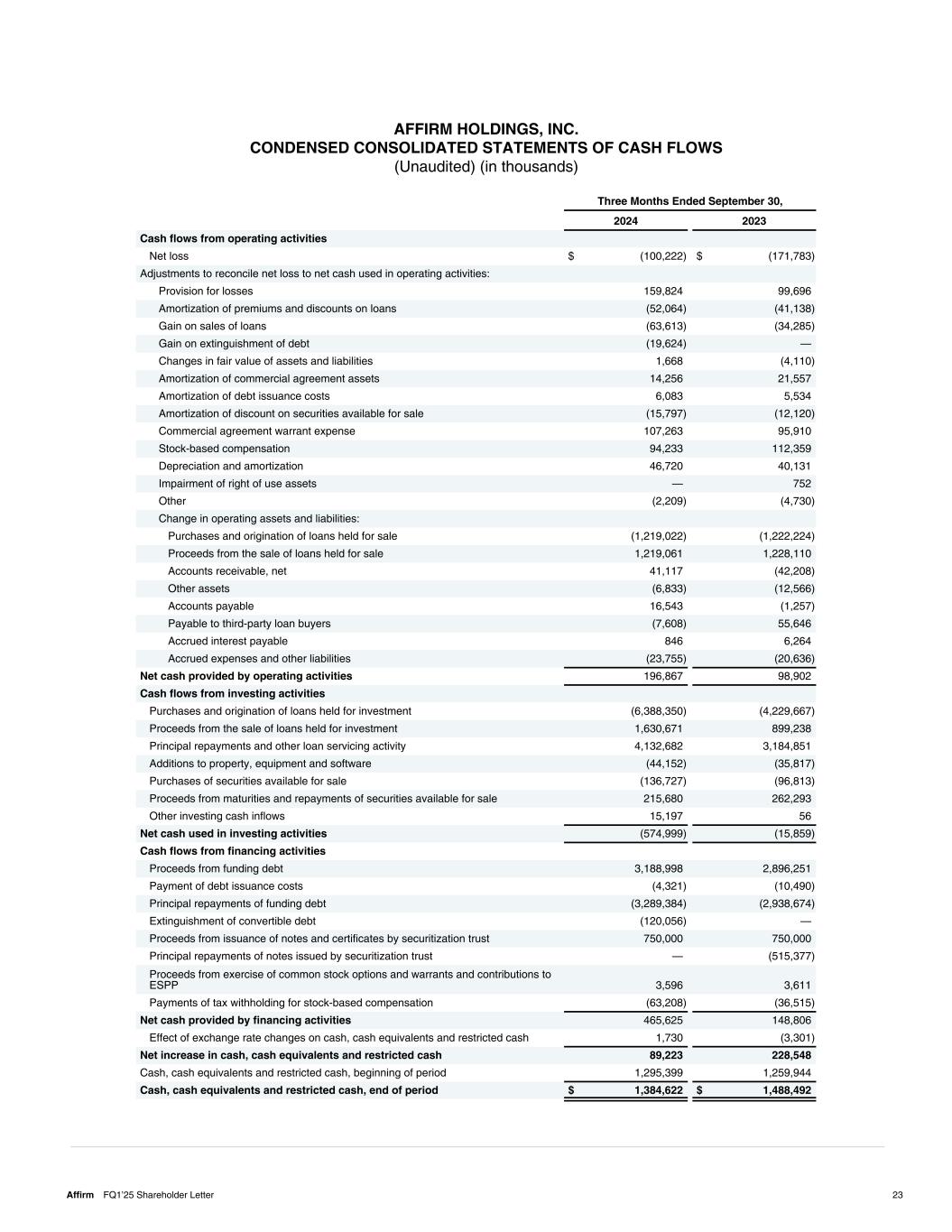
AFFIRM HOLDINGS, INC. CONDENSED CONSOLIDATED STATEMENTS OF CASH FLOWS (Unaudited) (in thousands) Three Months Ended September 30, 2024 2023 Cash flows from operating activities Net loss $ (100,222) $ (171,783) Adjustments to reconcile net loss to net cash used in operating activities: Provision for losses 159,824 99,696 Amortization of premiums and discounts on loans (52,064) (41,138) Gain on sales of loans (63,613) (34,285) Gain on extinguishment of debt (19,624) — Changes in fair value of assets and liabilities 1,668 (4,110) Amortization of commercial agreement assets 14,256 21,557 Amortization of debt issuance costs 6,083 5,534 Amortization of discount on securities available for sale (15,797) (12,120) Commercial agreement warrant expense 107,263 95,910 Stock-based compensation 94,233 112,359 Depreciation and amortization 46,720 40,131 Impairment of right of use assets — 752 Other (2,209) (4,730) Change in operating assets and liabilities: Purchases and origination of loans held for sale (1,219,022) (1,222,224) Proceeds from the sale of loans held for sale 1,219,061 1,228,110 Accounts receivable, net 41,117 (42,208) Other assets (6,833) (12,566) Accounts payable 16,543 (1,257) Payable to third-party loan buyers (7,608) 55,646 Accrued interest payable 846 6,264 Accrued expenses and other liabilities (23,755) (20,636) Net cash provided by operating activities 196,867 98,902 Cash flows from investing activities Purchases and origination of loans held for investment (6,388,350) (4,229,667) Proceeds from the sale of loans held for investment 1,630,671 899,238 Principal repayments and other loan servicing activity 4,132,682 3,184,851 Additions to property, equipment and software (44,152) (35,817) Purchases of securities available for sale (136,727) (96,813) Proceeds from maturities and repayments of securities available for sale 215,680 262,293 Other investing cash inflows 15,197 56 Net cash used in investing activities (574,999) (15,859) Cash flows from financing activities Proceeds from funding debt 3,188,998 2,896,251 Payment of debt issuance costs (4,321) (10,490) Principal repayments of funding debt (3,289,384) (2,938,674) Extinguishment of convertible debt (120,056) — Proceeds from issuance of notes and certificates by securitization trust 750,000 750,000 Principal repayments of notes issued by securitization trust — (515,377) Proceeds from exercise of common stock options and warrants and contributions to ESPP 3,596 3,611 Payments of tax withholding for stock-based compensation (63,208) (36,515) Net cash provided by financing activities 465,625 148,806 Effect of exchange rate changes on cash, cash equivalents and restricted cash 1,730 (3,301) Net increase in cash, cash equivalents and restricted cash 89,223 228,548 Cash, cash equivalents and restricted cash, beginning of period 1,295,399 1,259,944 Cash, cash equivalents and restricted cash, end of period $ 1,384,622 $ 1,488,492 Affirm FQ1’25 Shareholder Letter 23
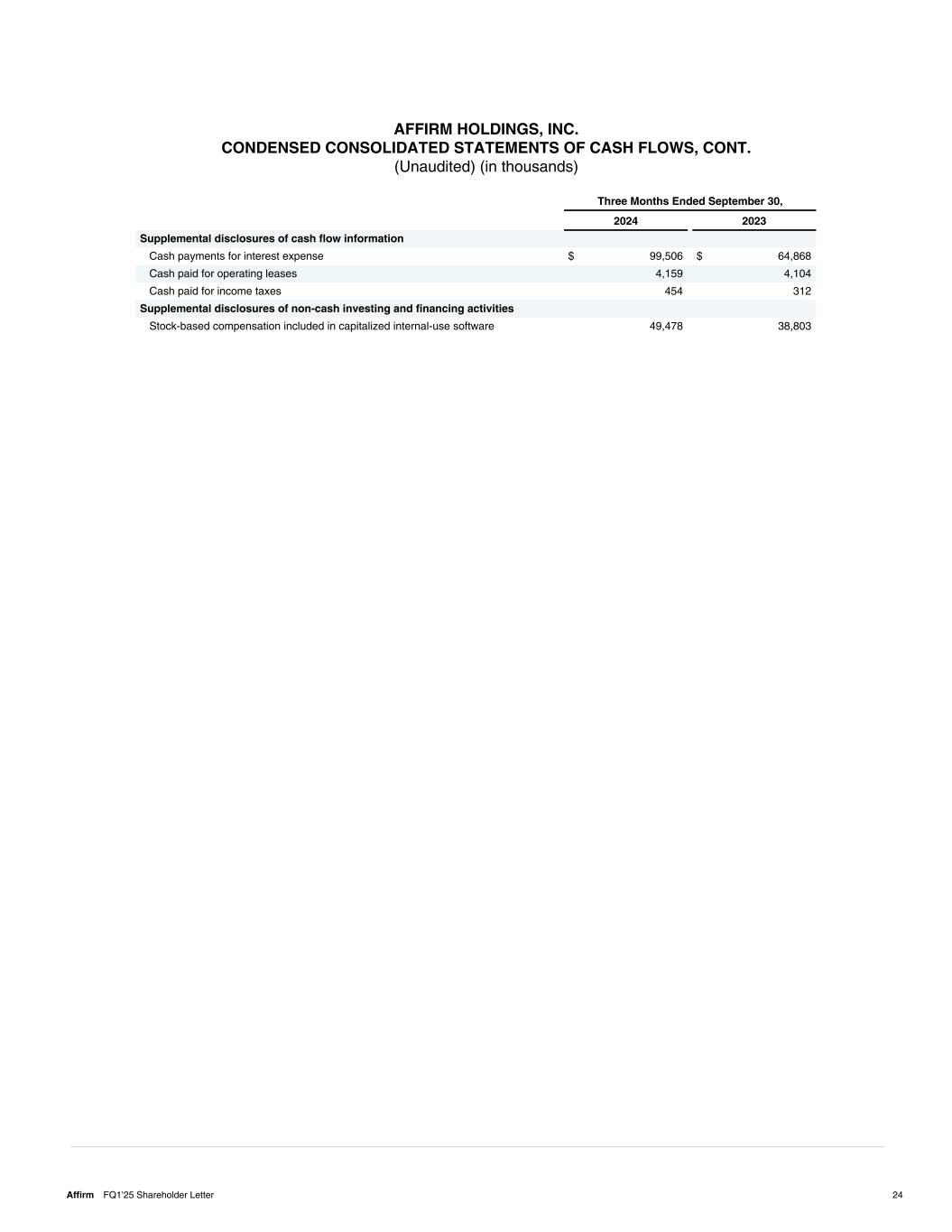
AFFIRM HOLDINGS, INC. CONDENSED CONSOLIDATED STATEMENTS OF CASH FLOWS, CONT. (Unaudited) (in thousands) Three Months Ended September 30, 2024 2023 Supplemental disclosures of cash flow information Cash payments for interest expense $ 99,506 $ 64,868 Cash paid for operating leases 4,159 4,104 Cash paid for income taxes 454 312 Supplemental disclosures of non-cash investing and financing activities Stock-based compensation included in capitalized internal-use software 49,478 38,803 Affirm FQ1’25 Shareholder Letter 24
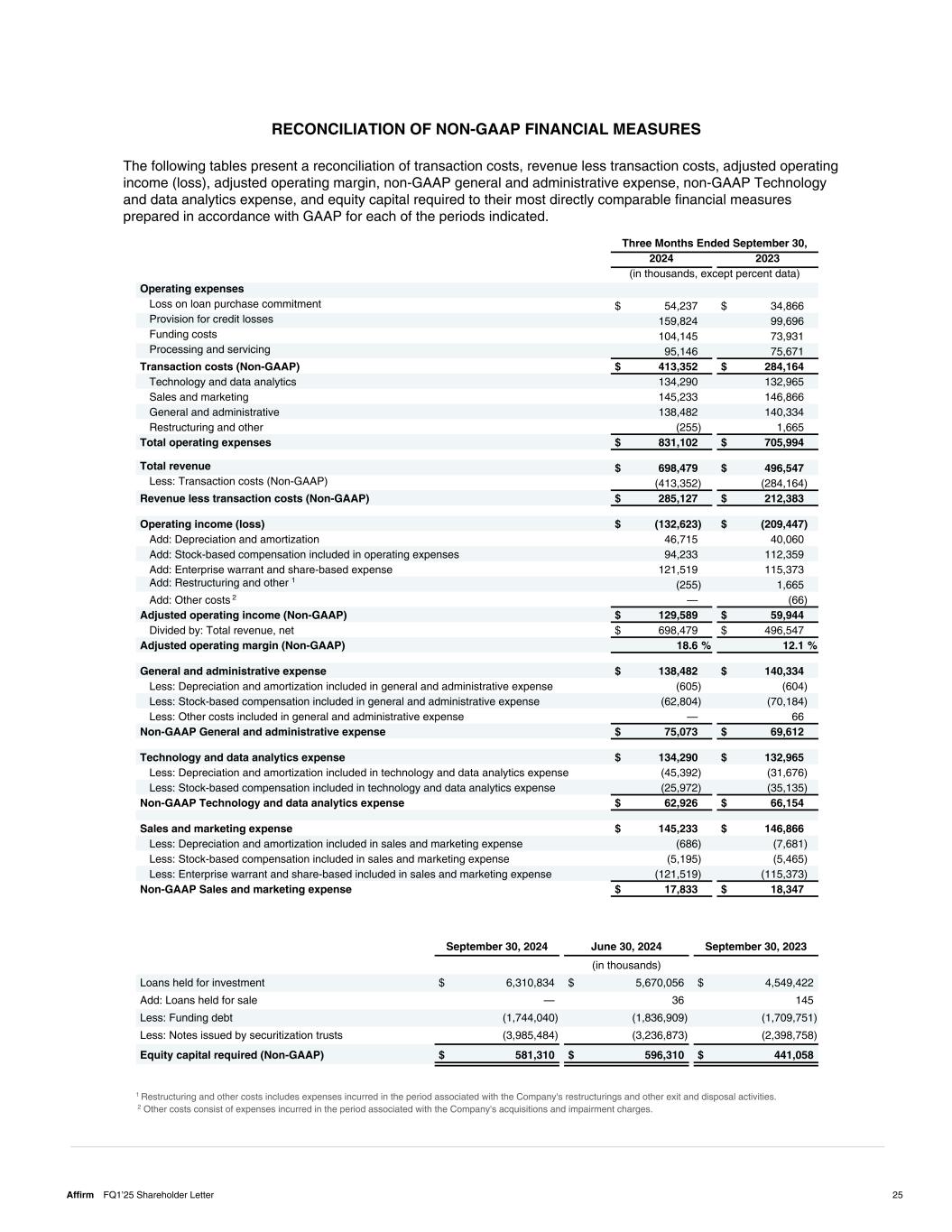
RECONCILIATION OF NON-GAAP FINANCIAL MEASURES The following tables present a reconciliation of transaction costs, revenue less transaction costs, adjusted operating income (loss), adjusted operating margin, non-GAAP general and administrative expense, non-GAAP Technology and data analytics expense, and equity capital required to their most directly comparable financial measures prepared in accordance with GAAP for each of the periods indicated. Three Months Ended September 30, 2024 2023 (in thousands, except percent data) Operating expenses Loss on loan purchase commitment $ 54,237 $ 34,866 Provision for credit losses 159,824 99,696 Funding costs 104,145 73,931 Processing and servicing 95,146 75,671 Transaction costs (Non-GAAP) $ 413,352 $ 284,164 Technology and data analytics 134,290 132,965 Sales and marketing 145,233 146,866 General and administrative 138,482 140,334 Restructuring and other (255) 1,665 Total operating expenses $ 831,102 $ 705,994 Total revenue $ 698,479 $ 496,547 Less: Transaction costs (Non-GAAP) (413,352) (284,164) Revenue less transaction costs (Non-GAAP) $ 285,127 $ 212,383 Operating income (loss) $ (132,623) $ (209,447) Add: Depreciation and amortization 46,715 40,060 Add: Stock-based compensation included in operating expenses 94,233 112,359 Add: Enterprise warrant and share-based expense 121,519 115,373 Add: Restructuring and other 1 (255) 1,665 Add: Other costs 2 — (66) Adjusted operating income (Non-GAAP) $ 129,589 $ 59,944 Divided by: Total revenue, net $ 698,479 $ 496,547 Adjusted operating margin (Non-GAAP) 18.6 % 12.1 % General and administrative expense $ 138,482 $ 140,334 Less: Depreciation and amortization included in general and administrative expense (605) (604) Less: Stock-based compensation included in general and administrative expense (62,804) (70,184) Less: Other costs included in general and administrative expense — 66 Non-GAAP General and administrative expense $ 75,073 $ 69,612 Technology and data analytics expense $ 134,290 $ 132,965 Less: Depreciation and amortization included in technology and data analytics expense (45,392) (31,676) Less: Stock-based compensation included in technology and data analytics expense (25,972) (35,135) Non-GAAP Technology and data analytics expense $ 62,926 $ 66,154 Sales and marketing expense $ 145,233 $ 146,866 Less: Depreciation and amortization included in sales and marketing expense (686) (7,681) Less: Stock-based compensation included in sales and marketing expense (5,195) (5,465) Less: Enterprise warrant and share-based included in sales and marketing expense (121,519) (115,373) Non-GAAP Sales and marketing expense $ 17,833 $ 18,347 September 30, 2024 June 30, 2024 September 30, 2023 (in thousands) Loans held for investment $ 6,310,834 $ 5,670,056 $ 4,549,422 Add: Loans held for sale — 36 145 Less: Funding debt (1,744,040) (1,836,909) (1,709,751) Less: Notes issued by securitization trusts (3,985,484) (3,236,873) (2,398,758) Equity capital required (Non-GAAP) $ 581,310 $ 596,310 $ 441,058 1 Restructuring and other costs includes expenses incurred in the period associated with the Company's restructurings and other exit and disposal activities. 2 Other costs consist of expenses incurred in the period associated with the Company's acquisitions and impairment charges. Affirm FQ1’25 Shareholder Letter 25
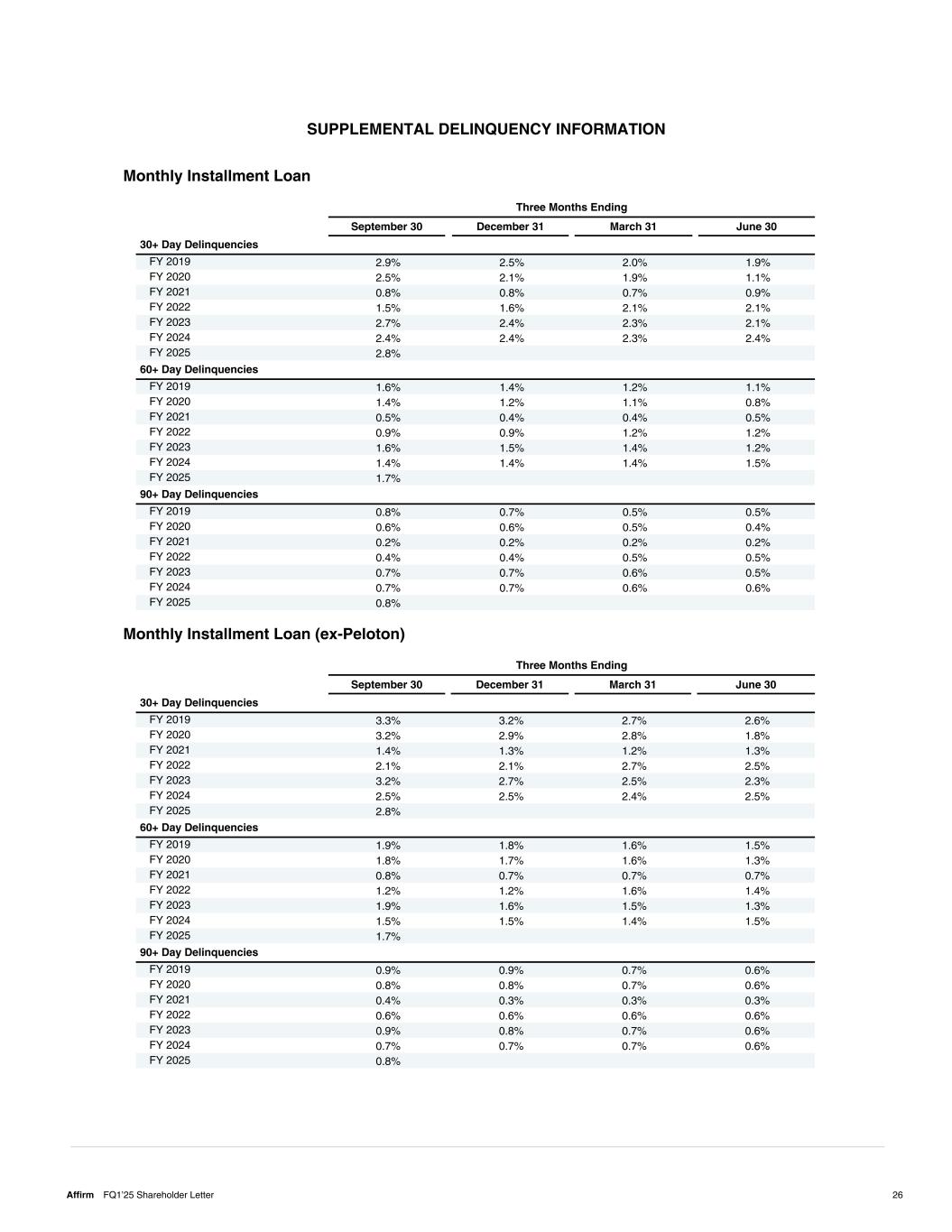
SUPPLEMENTAL DELINQUENCY INFORMATION Three Months Ending September 30 December 31 March 31 June 30 30+ Day Delinquencies FY 2019 2.9% 2.5% 2.0% 1.9% FY 2020 2.5% 2.1% 1.9% 1.1% FY 2021 0.8% 0.8% 0.7% 0.9% FY 2022 1.5% 1.6% 2.1% 2.1% FY 2023 2.7% 2.4% 2.3% 2.1% FY 2024 2.4% 2.4% 2.3% 2.4% FY 2025 2.8% 60+ Day Delinquencies FY 2019 1.6% 1.4% 1.2% 1.1% FY 2020 1.4% 1.2% 1.1% 0.8% FY 2021 0.5% 0.4% 0.4% 0.5% FY 2022 0.9% 0.9% 1.2% 1.2% FY 2023 1.6% 1.5% 1.4% 1.2% FY 2024 1.4% 1.4% 1.4% 1.5% FY 2025 1.7% 90+ Day Delinquencies FY 2019 0.8% 0.7% 0.5% 0.5% FY 2020 0.6% 0.6% 0.5% 0.4% FY 2021 0.2% 0.2% 0.2% 0.2% FY 2022 0.4% 0.4% 0.5% 0.5% FY 2023 0.7% 0.7% 0.6% 0.5% FY 2024 0.7% 0.7% 0.6% 0.6% FY 2025 0.8% Three Months Ending September 30 December 31 March 31 June 30 30+ Day Delinquencies FY 2019 3.3% 3.2% 2.7% 2.6% FY 2020 3.2% 2.9% 2.8% 1.8% FY 2021 1.4% 1.3% 1.2% 1.3% FY 2022 2.1% 2.1% 2.7% 2.5% FY 2023 3.2% 2.7% 2.5% 2.3% FY 2024 2.5% 2.5% 2.4% 2.5% FY 2025 2.8% 60+ Day Delinquencies FY 2019 1.9% 1.8% 1.6% 1.5% FY 2020 1.8% 1.7% 1.6% 1.3% FY 2021 0.8% 0.7% 0.7% 0.7% FY 2022 1.2% 1.2% 1.6% 1.4% FY 2023 1.9% 1.6% 1.5% 1.3% FY 2024 1.5% 1.5% 1.4% 1.5% FY 2025 1.7% 90+ Day Delinquencies FY 2019 0.9% 0.9% 0.7% 0.6% FY 2020 0.8% 0.8% 0.7% 0.6% FY 2021 0.4% 0.3% 0.3% 0.3% FY 2022 0.6% 0.6% 0.6% 0.6% FY 2023 0.9% 0.8% 0.7% 0.6% FY 2024 0.7% 0.7% 0.7% 0.6% FY 2025 0.8% Monthly Installment Loan (ex-Peloton) Monthly Installment Loan Affirm FQ1’25 Shareholder Letter 26

























